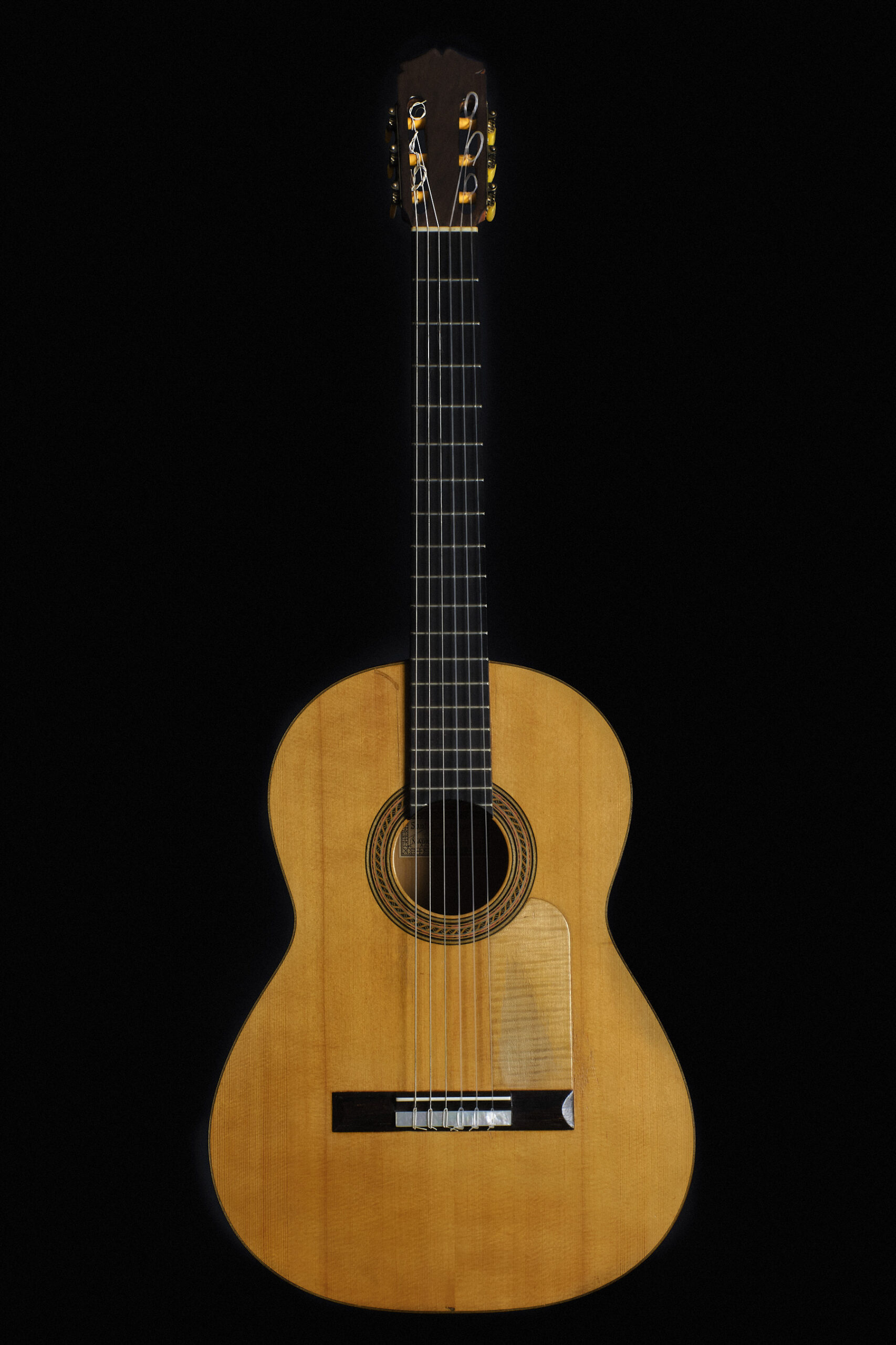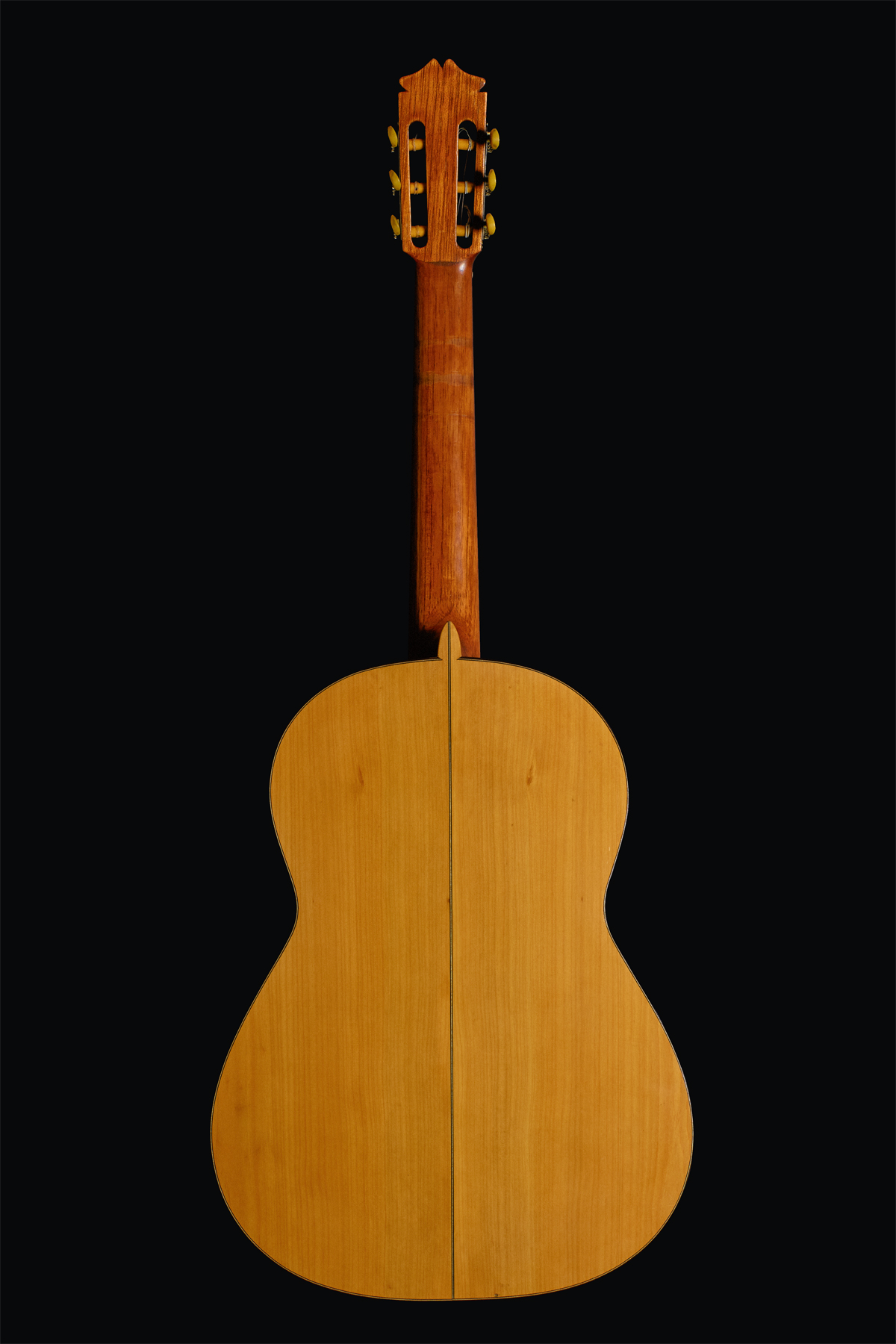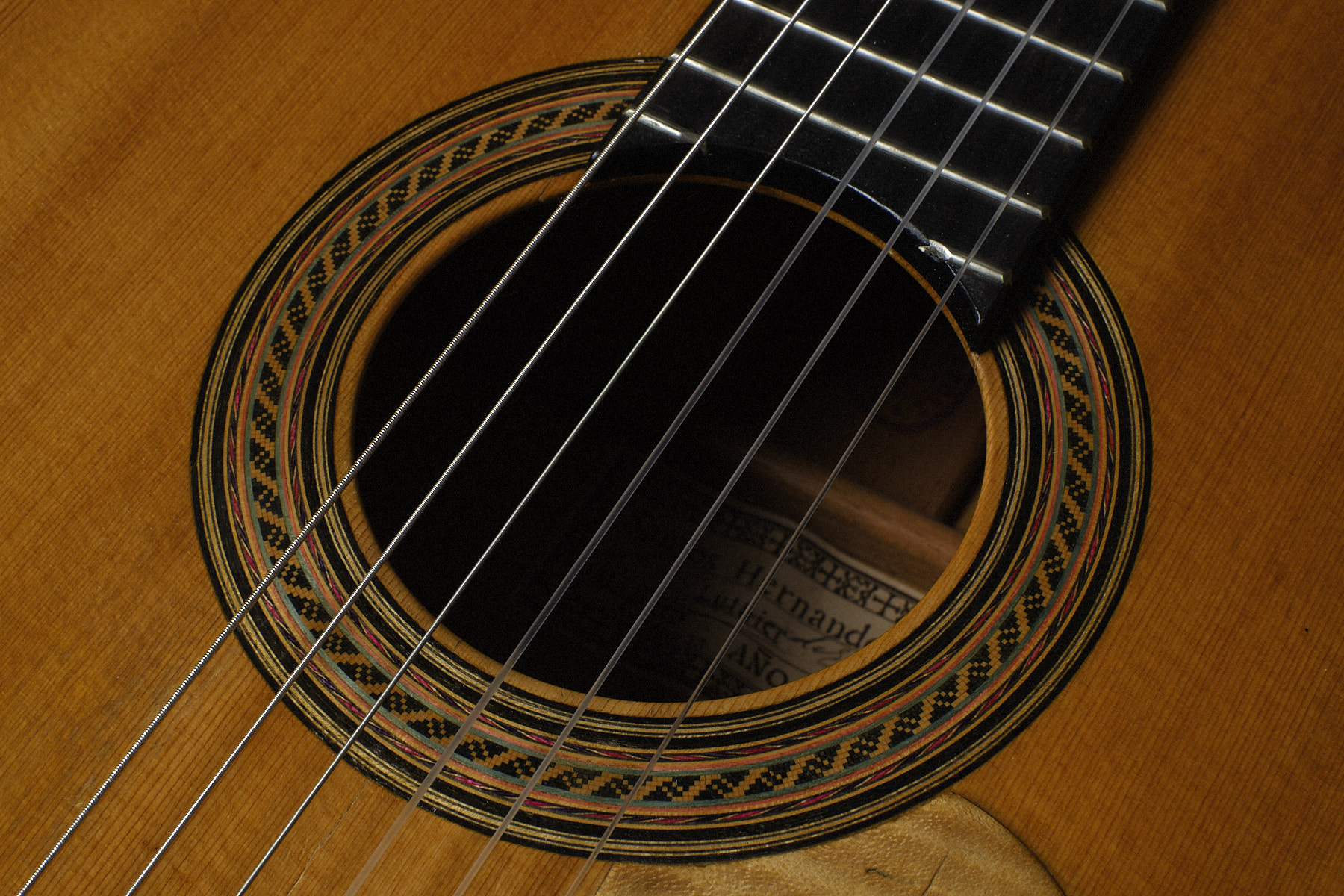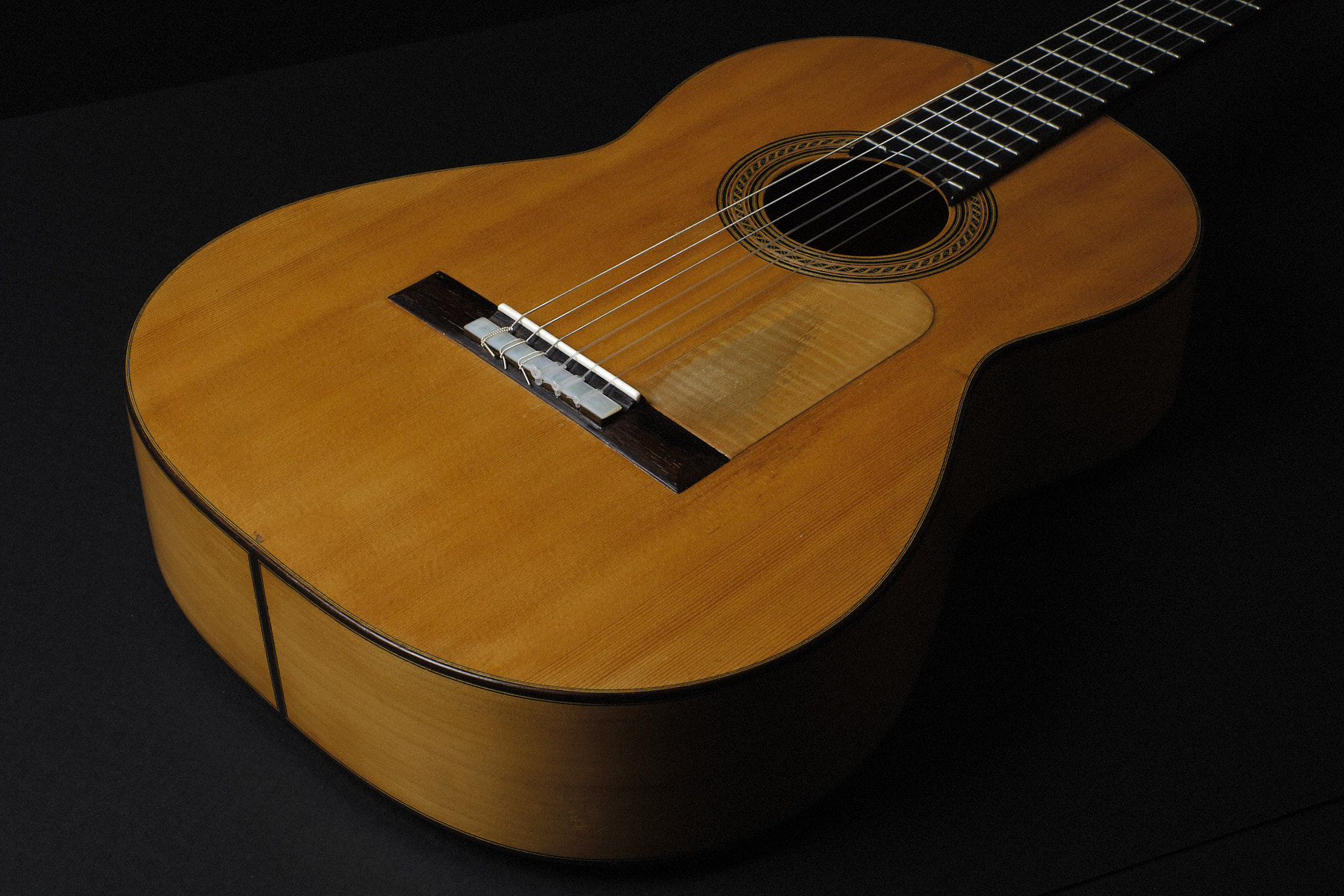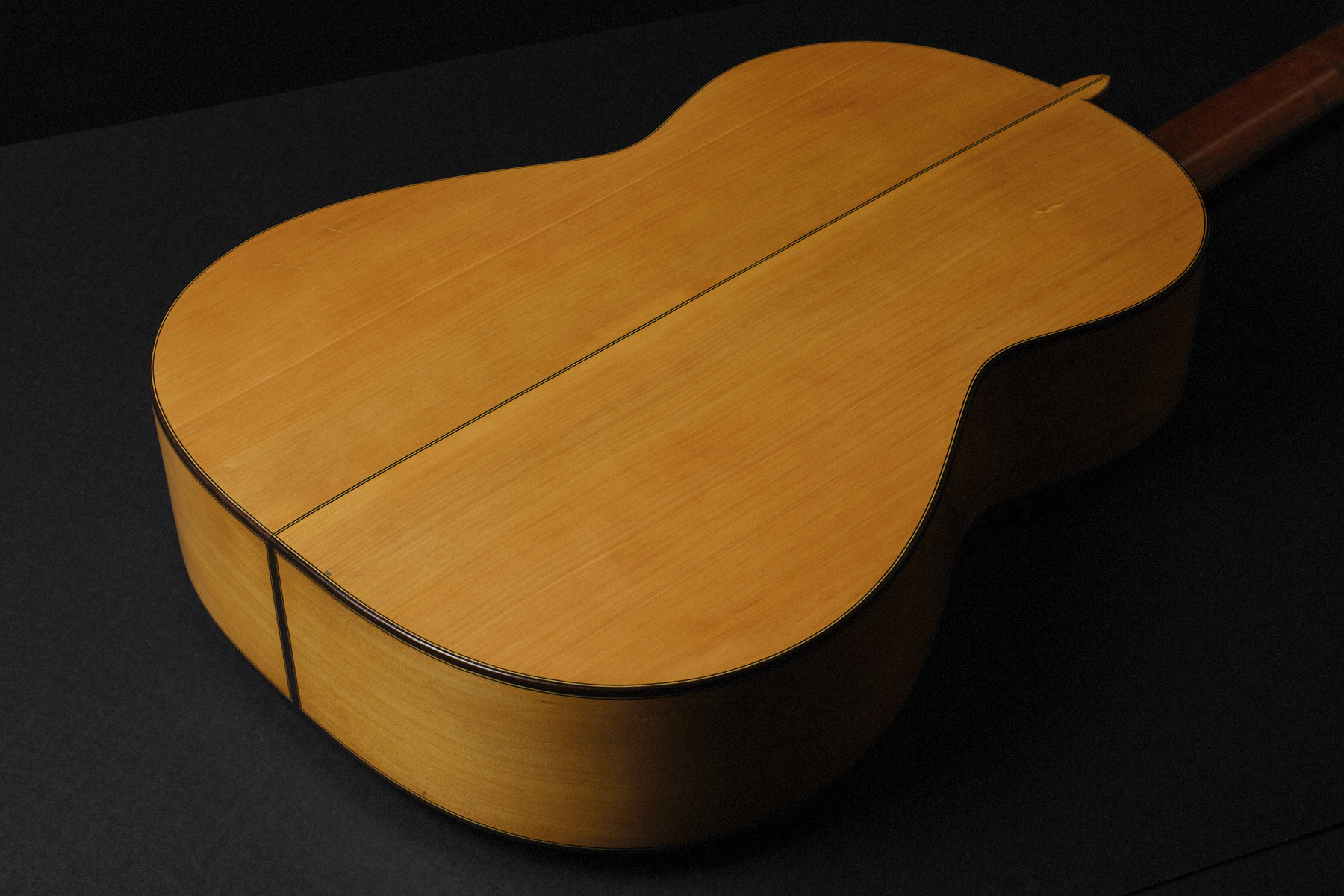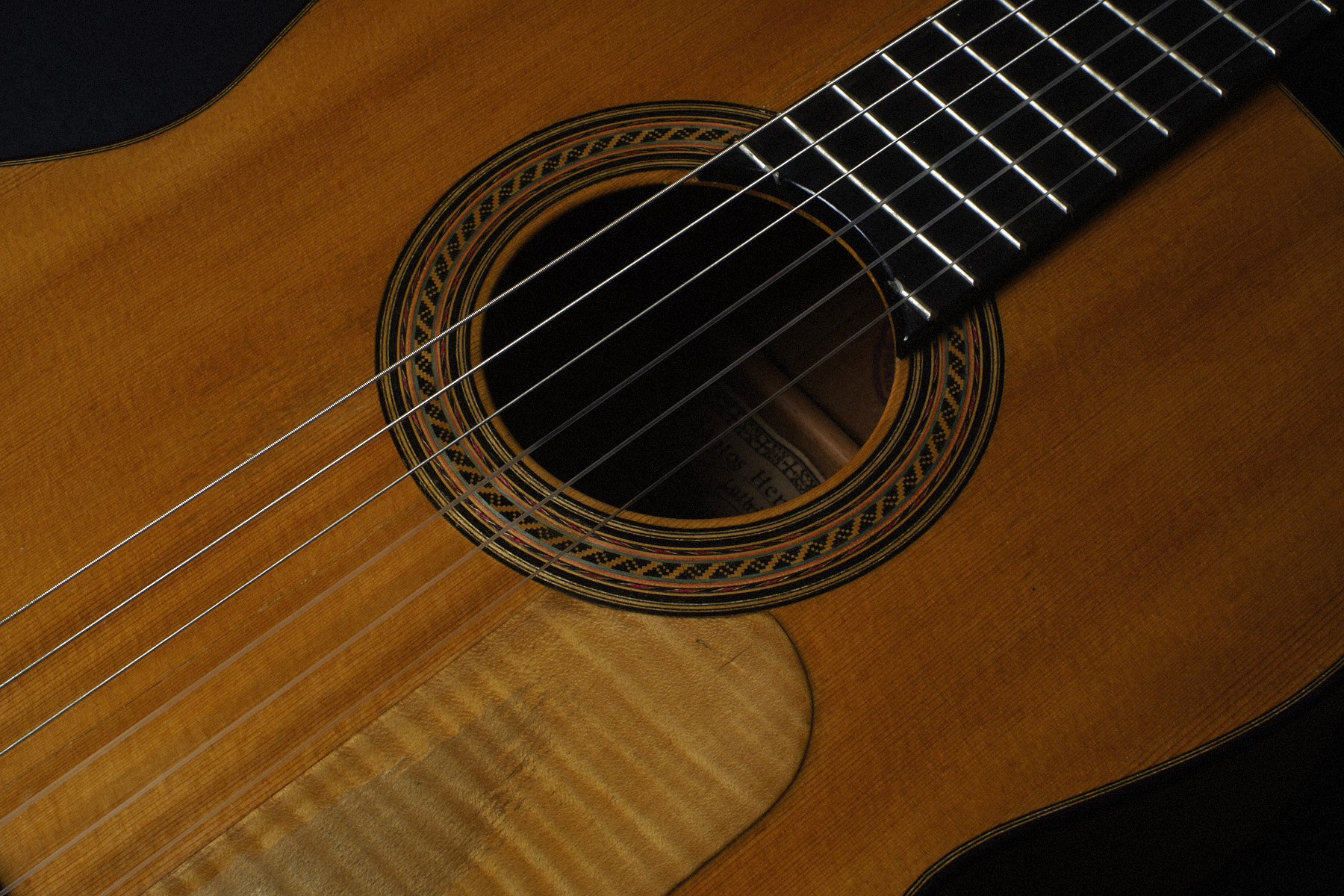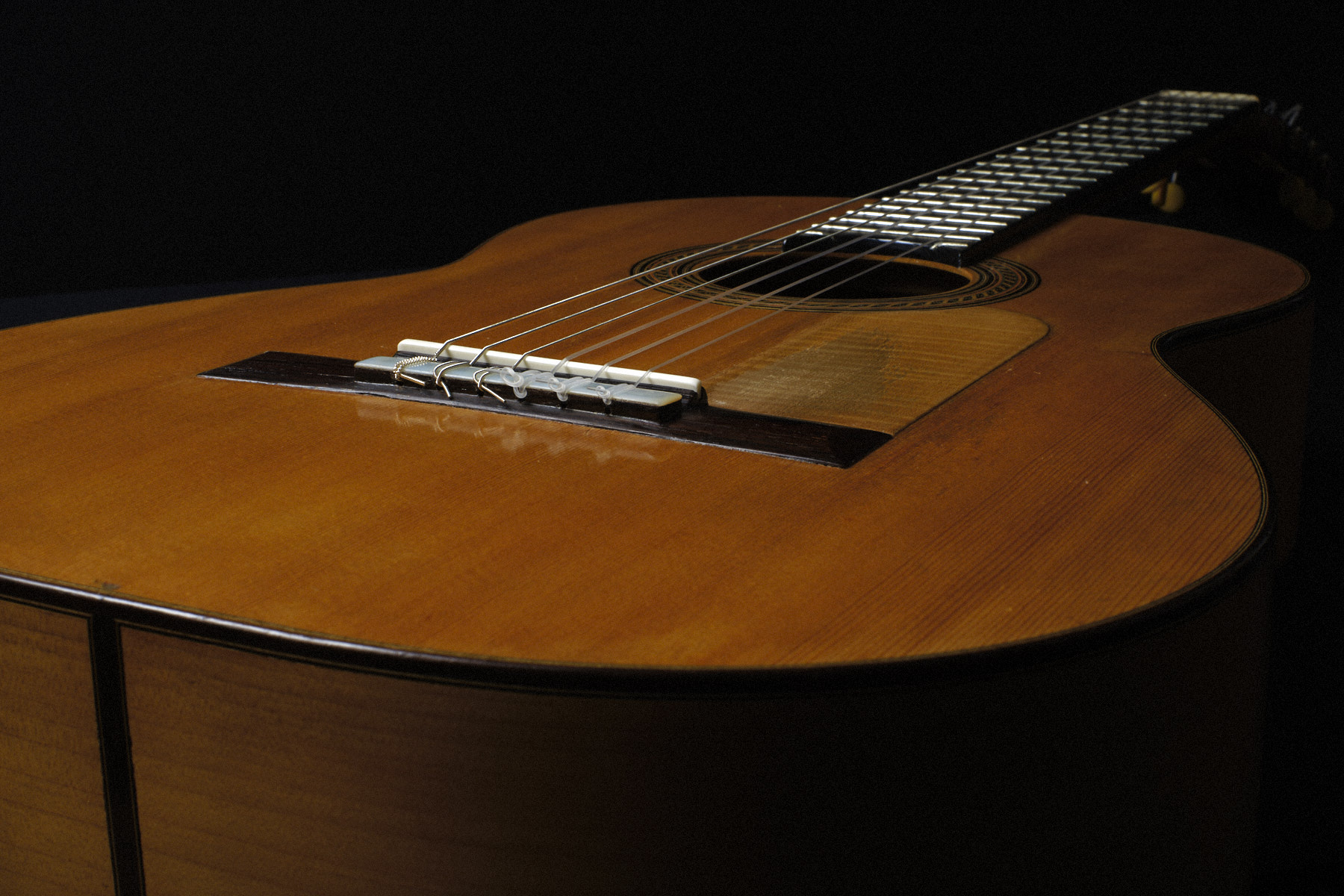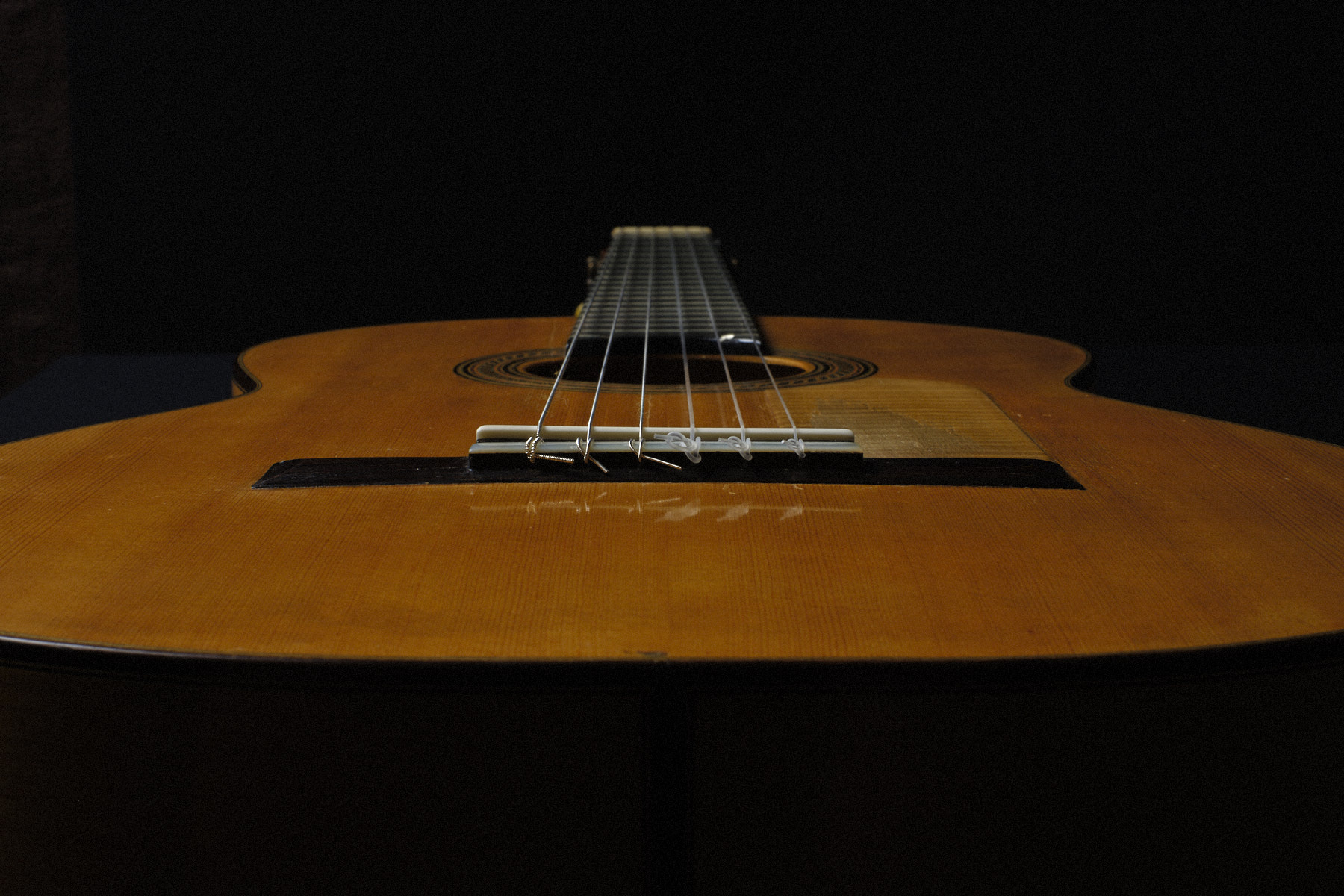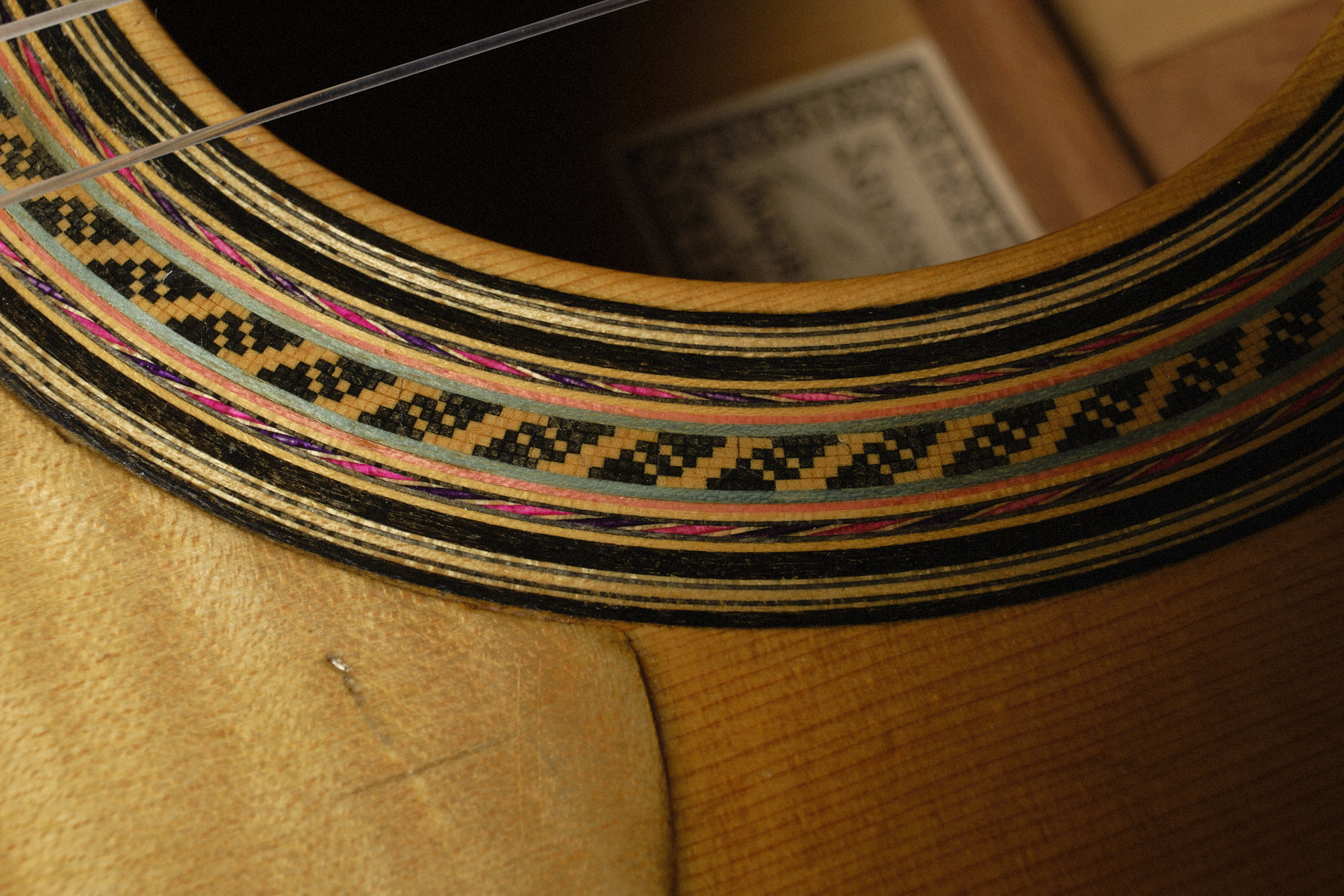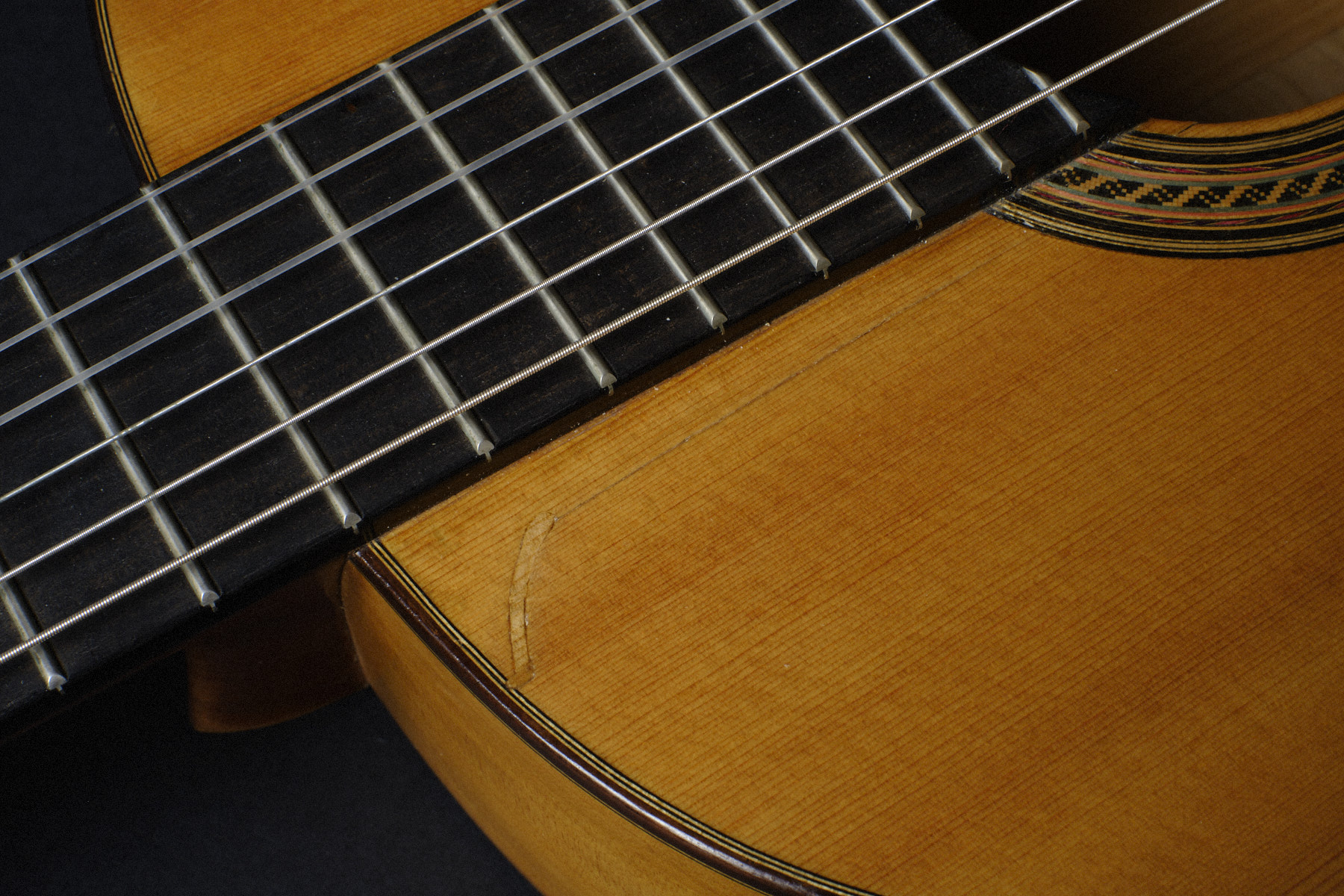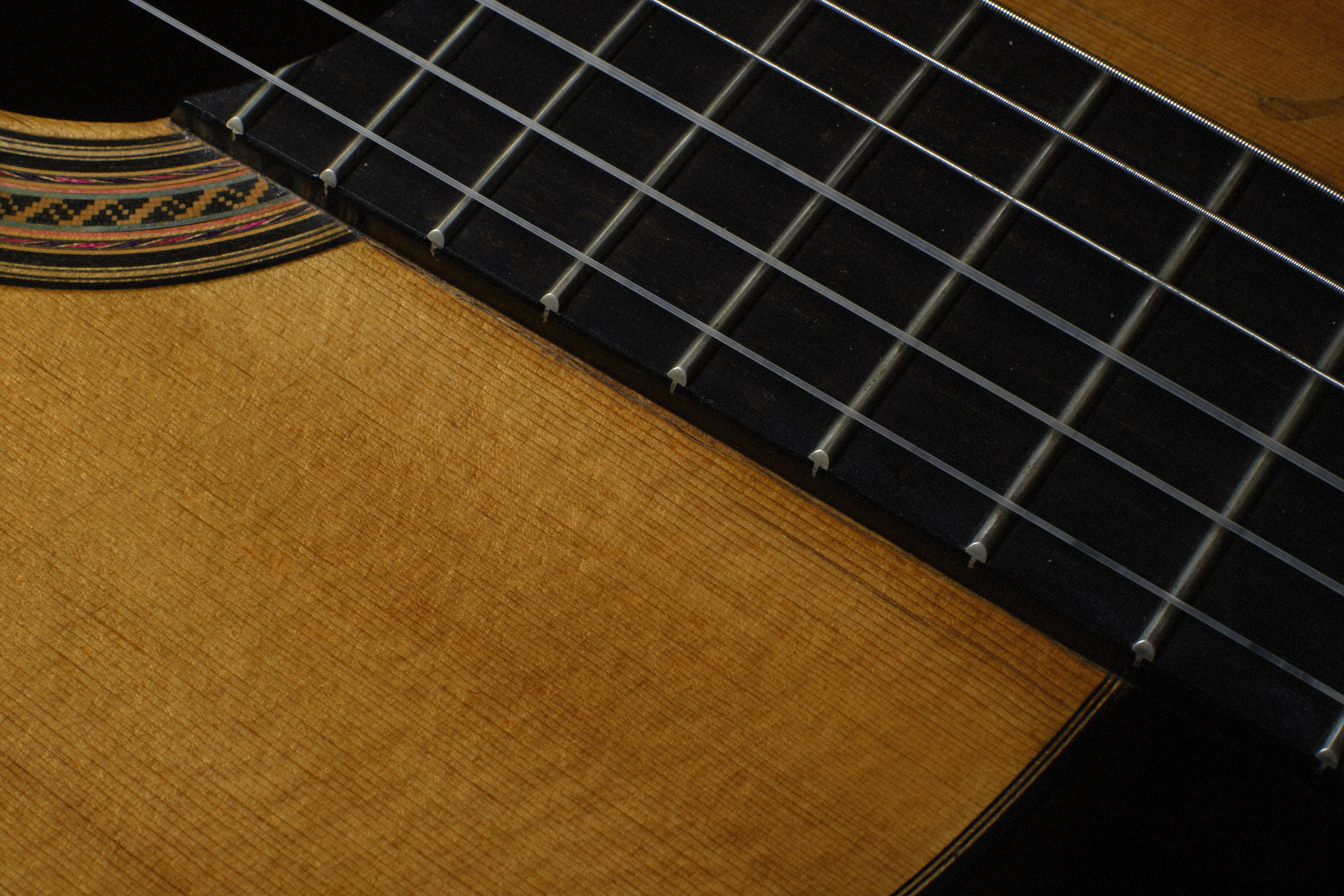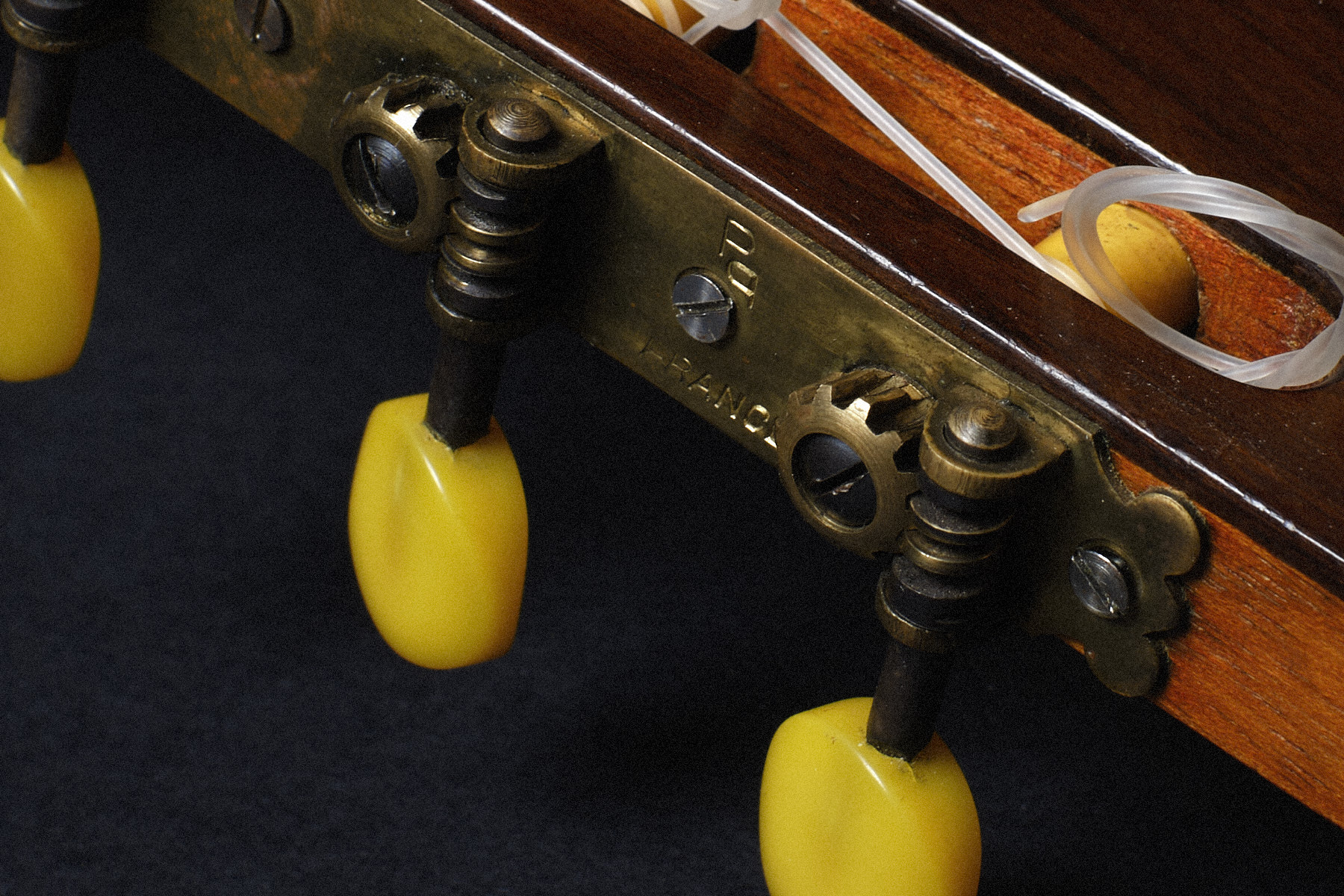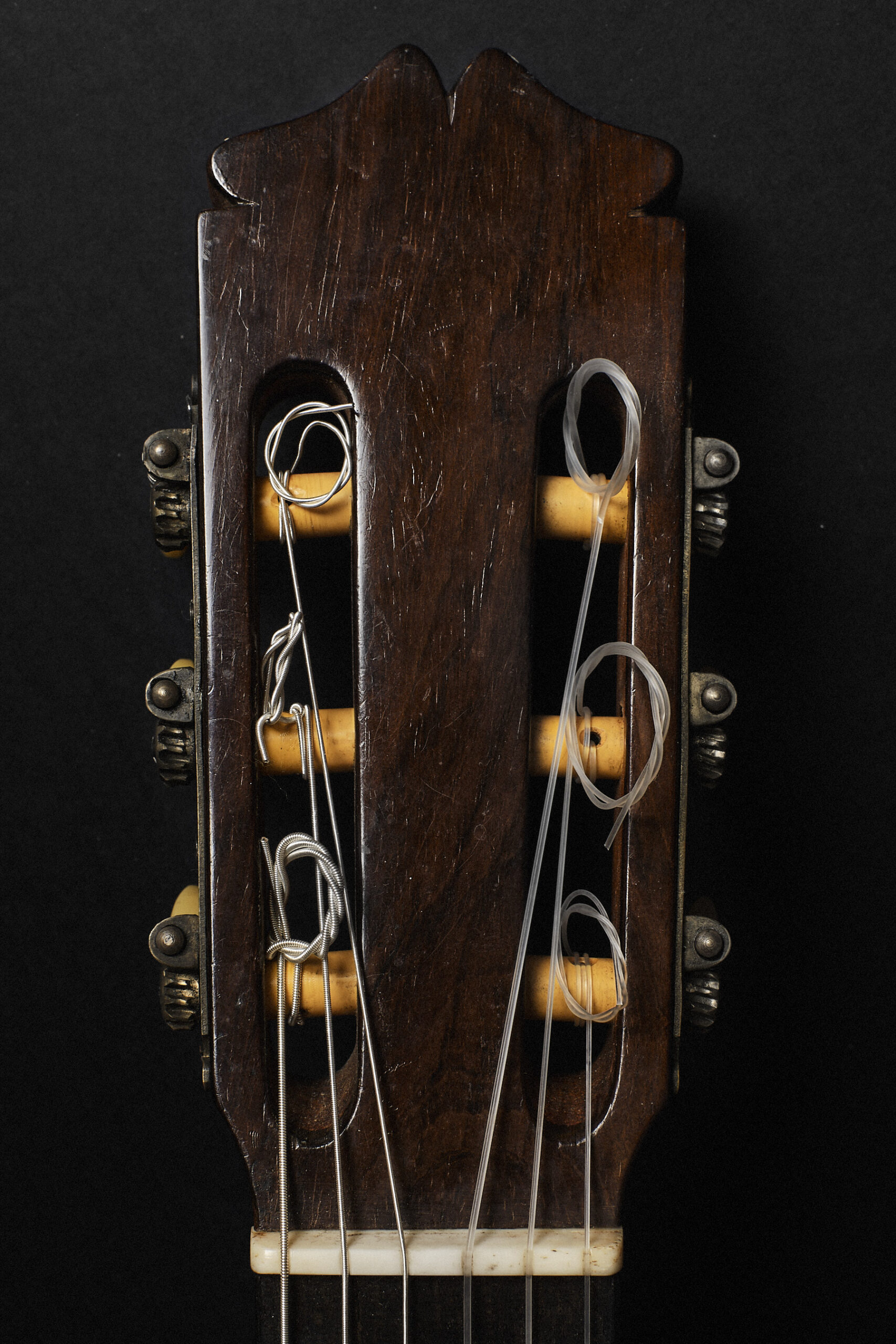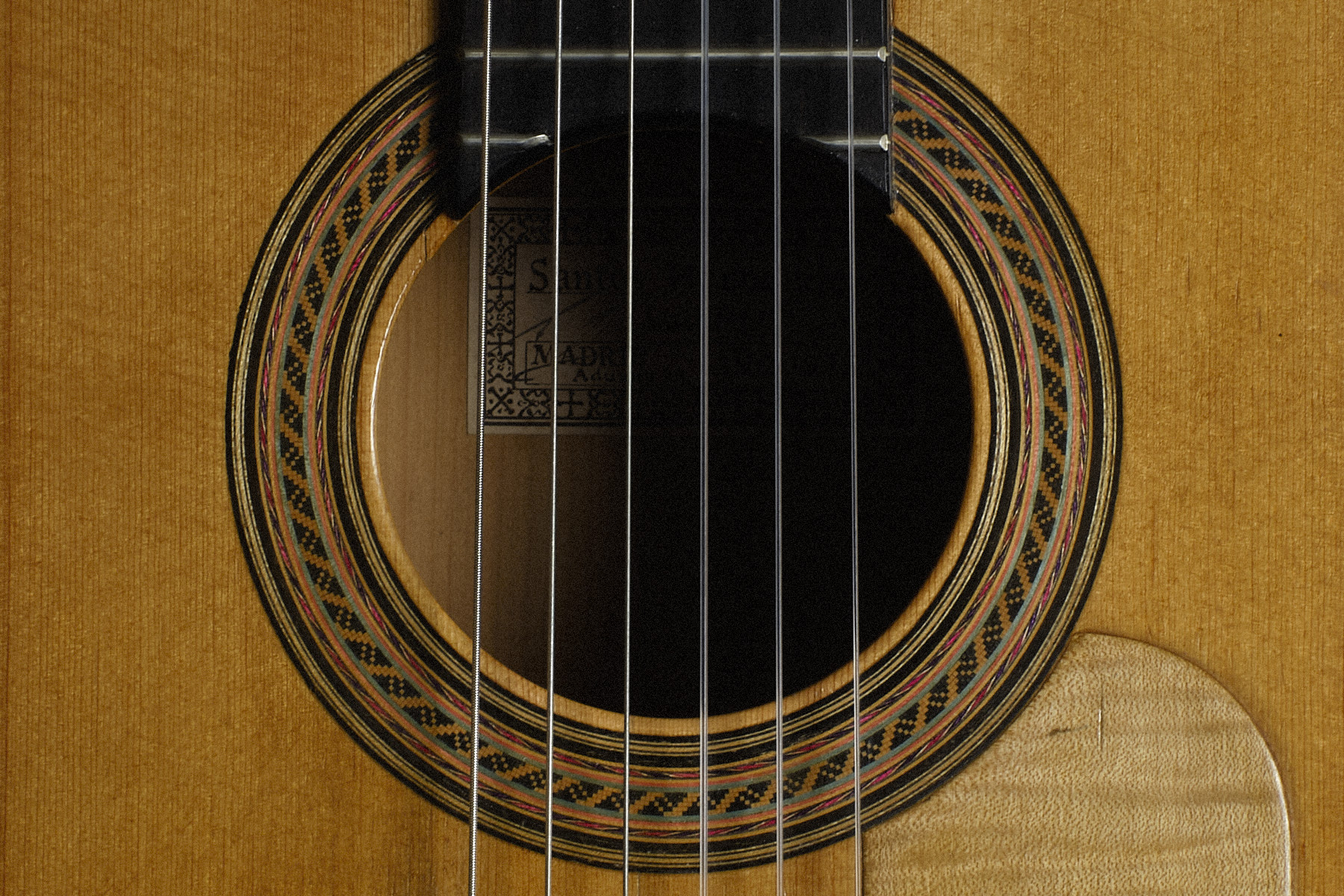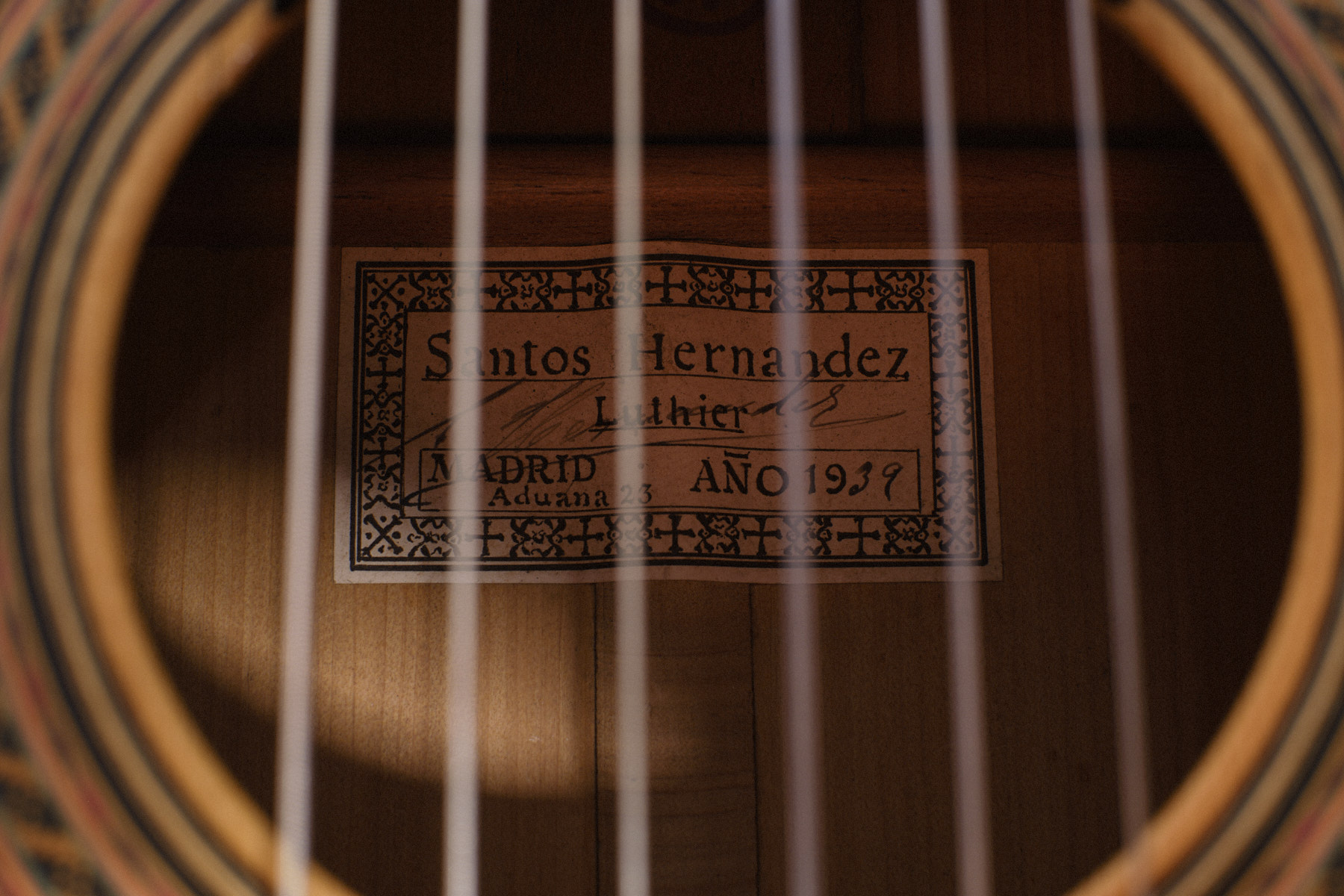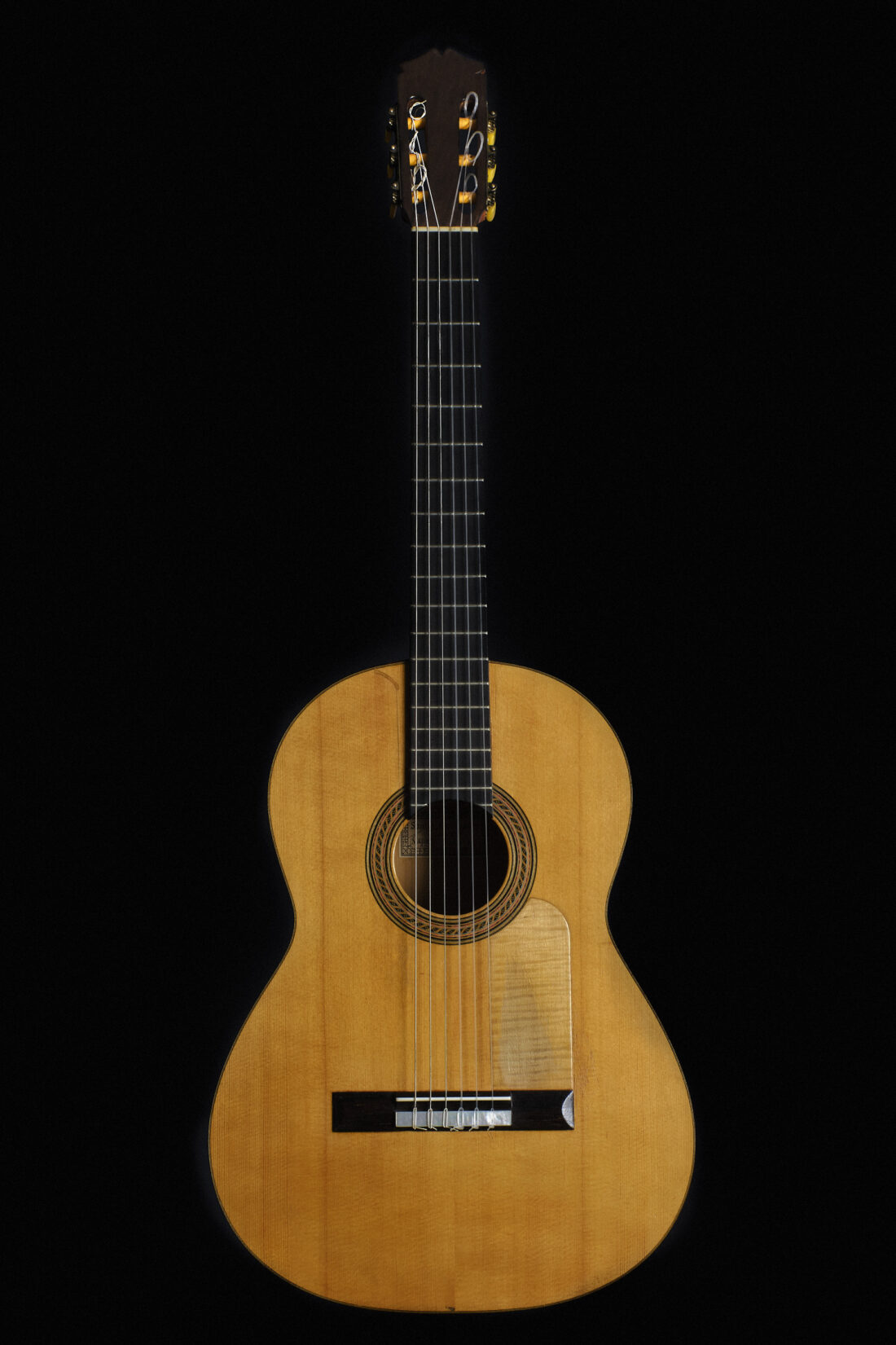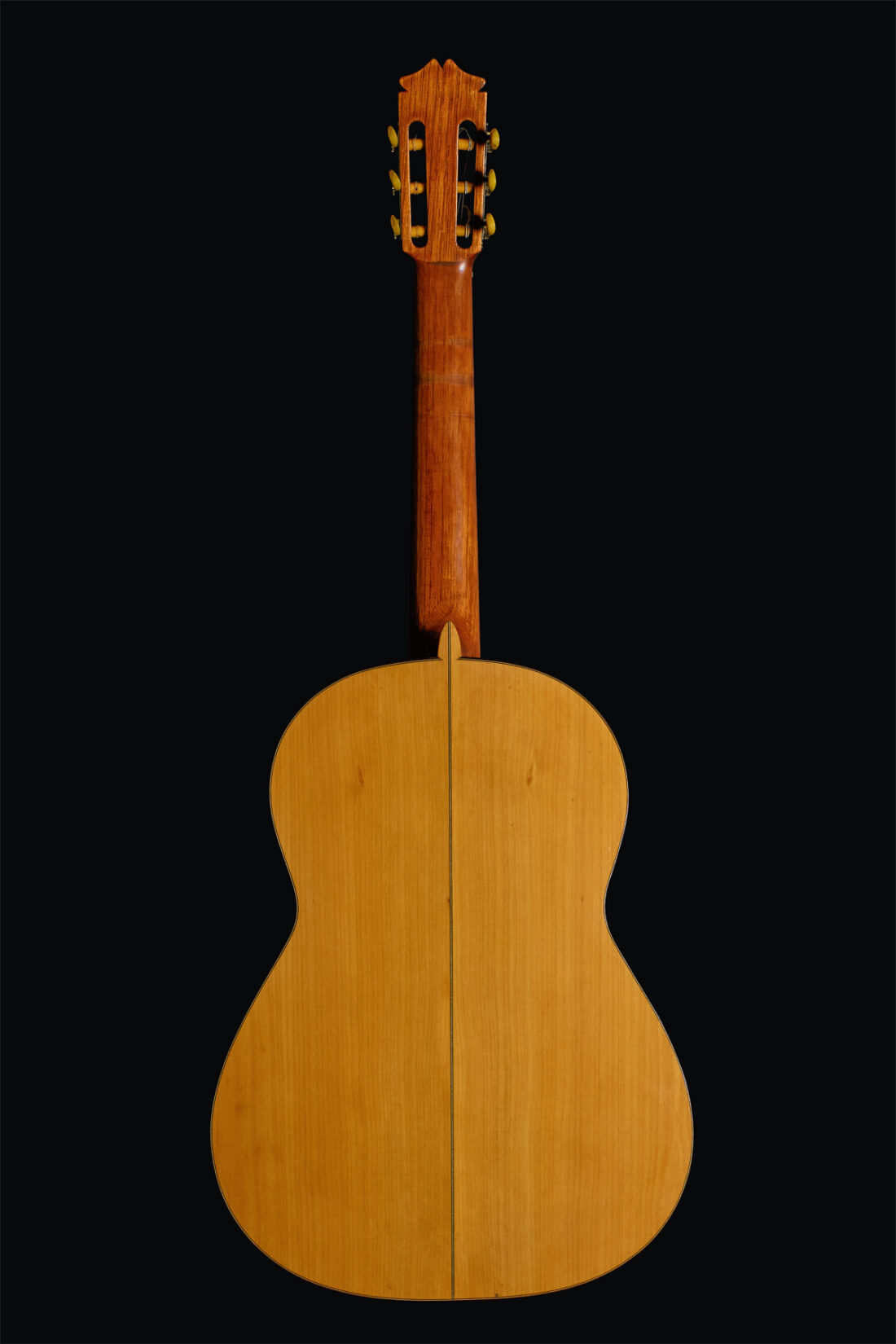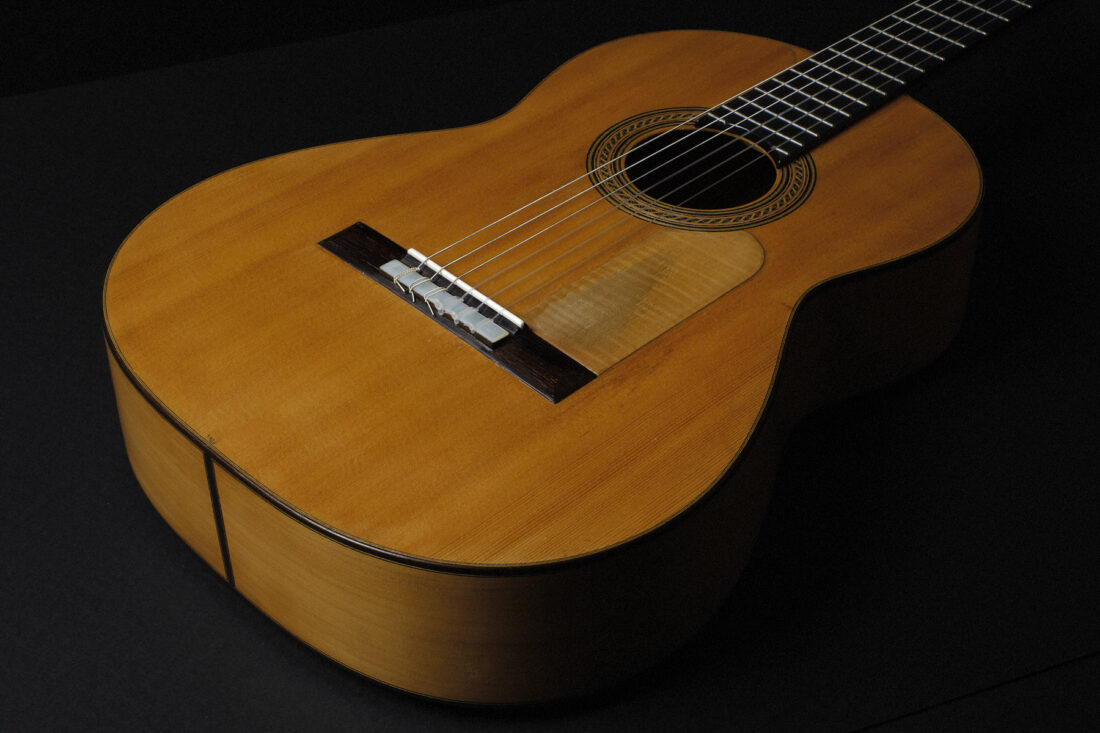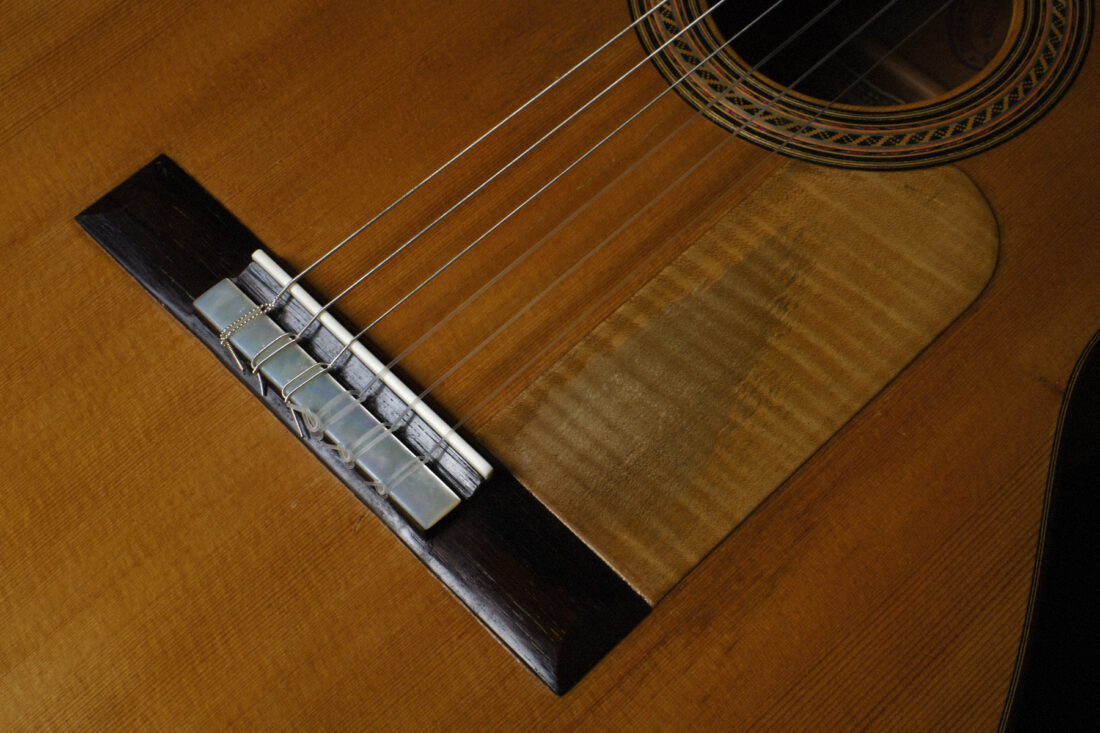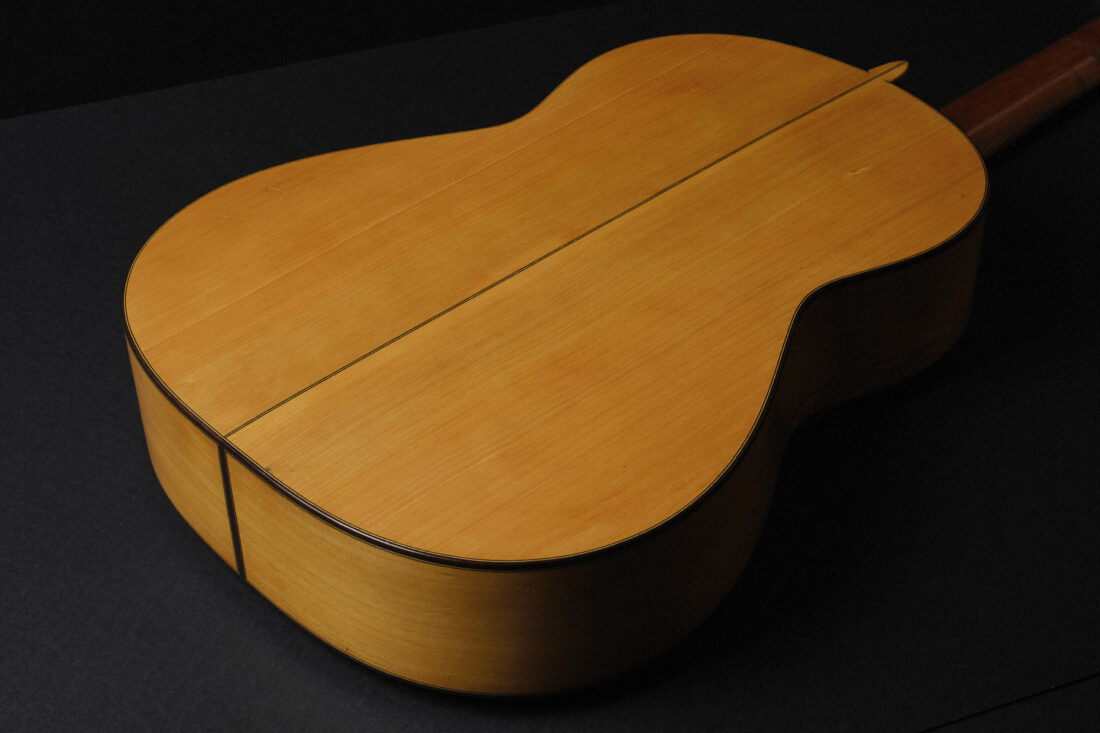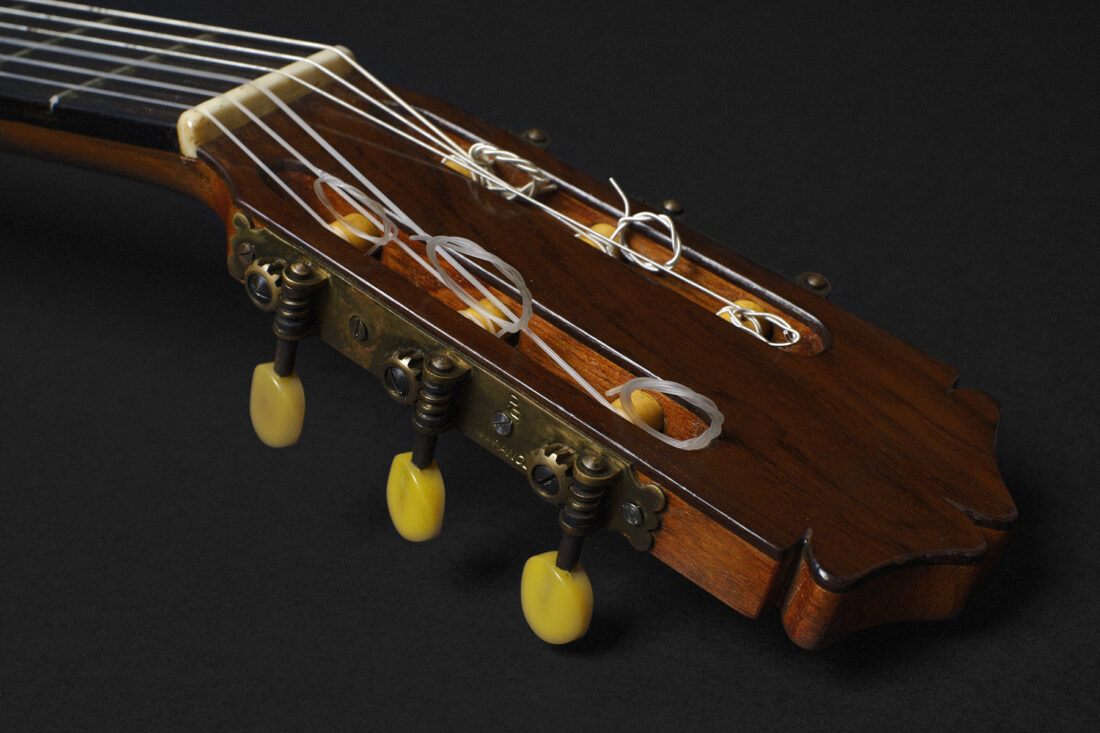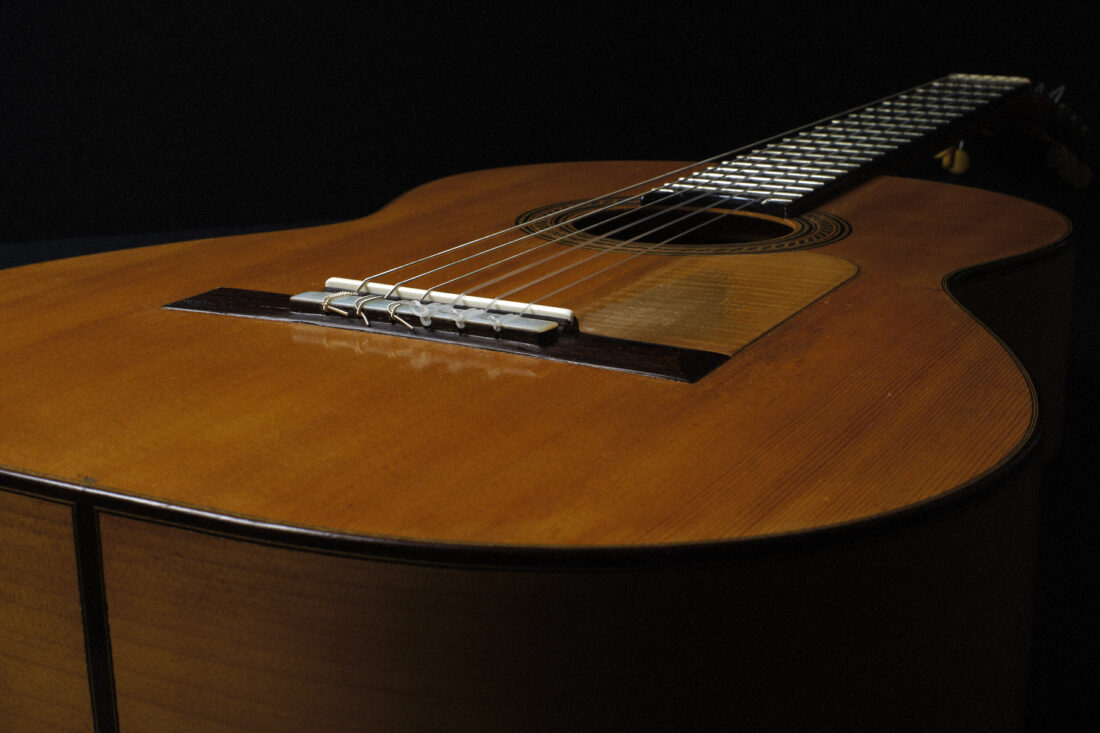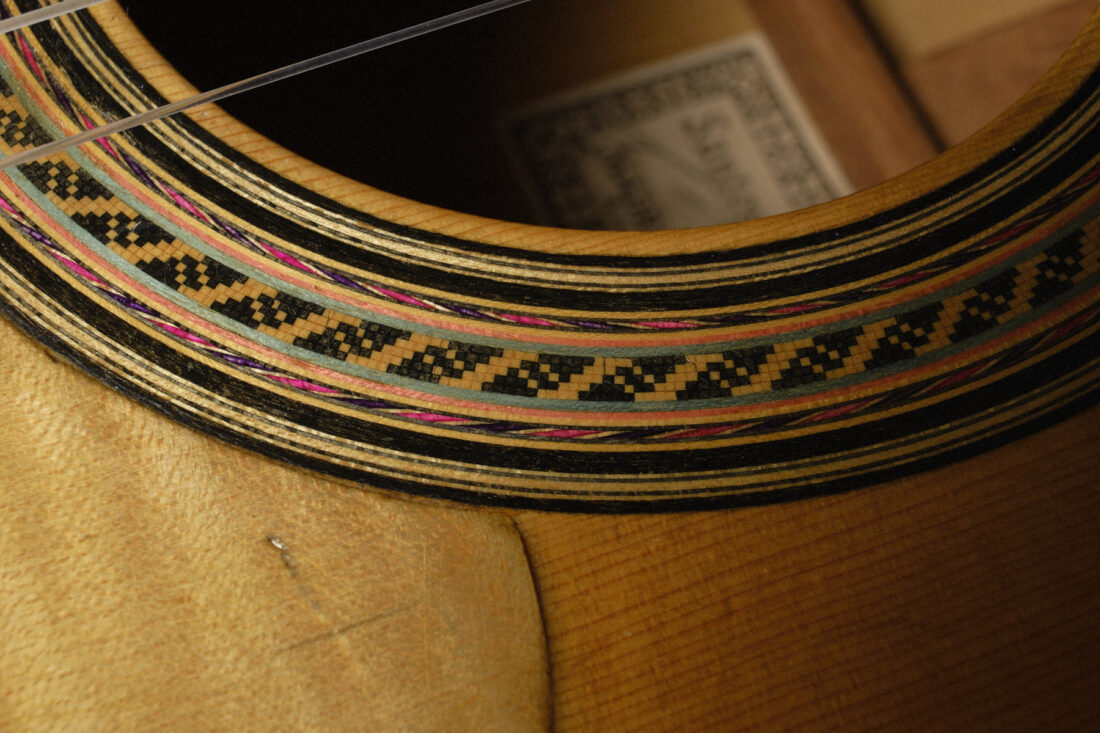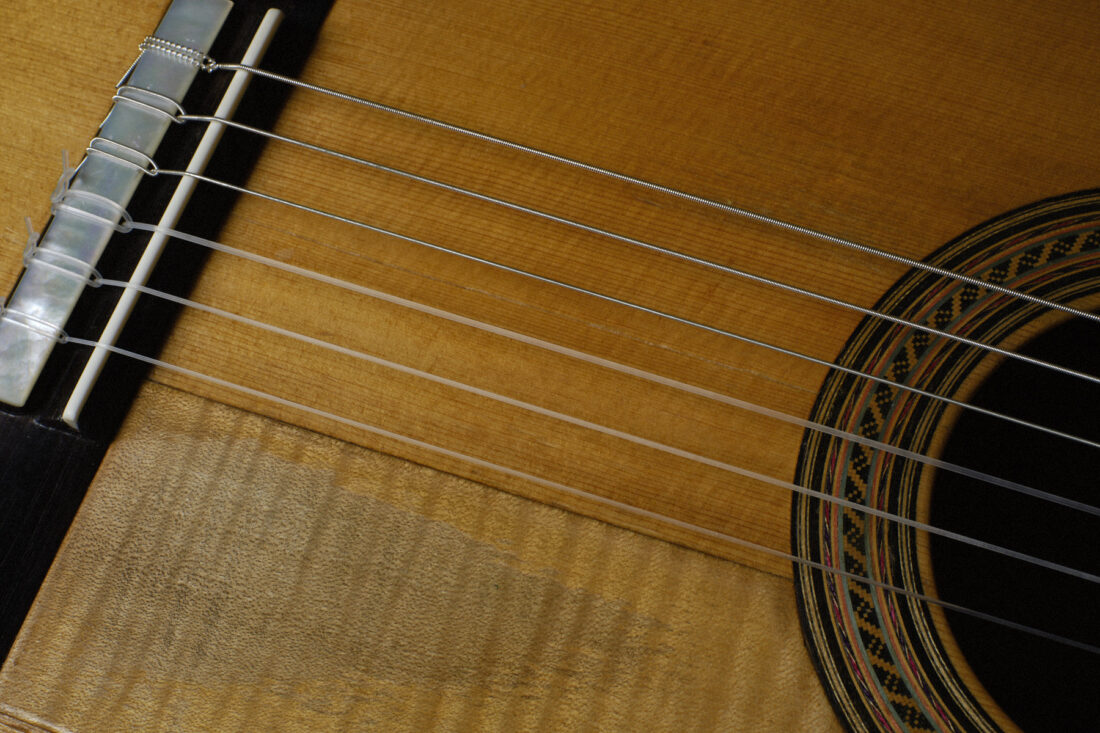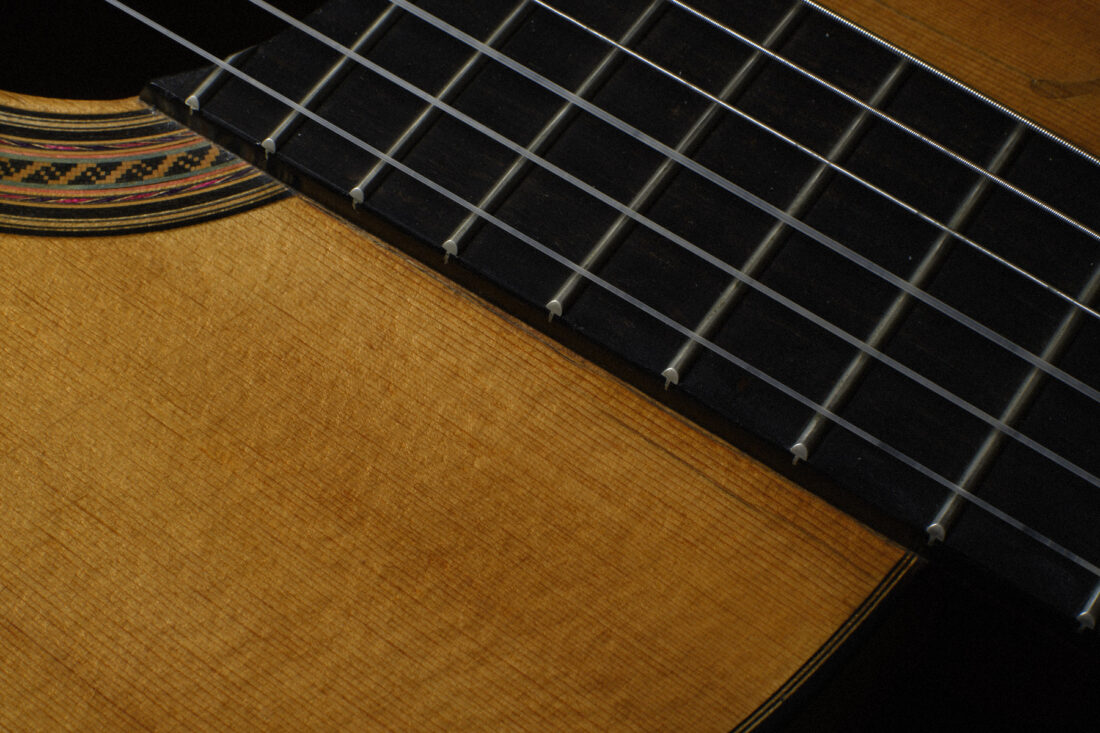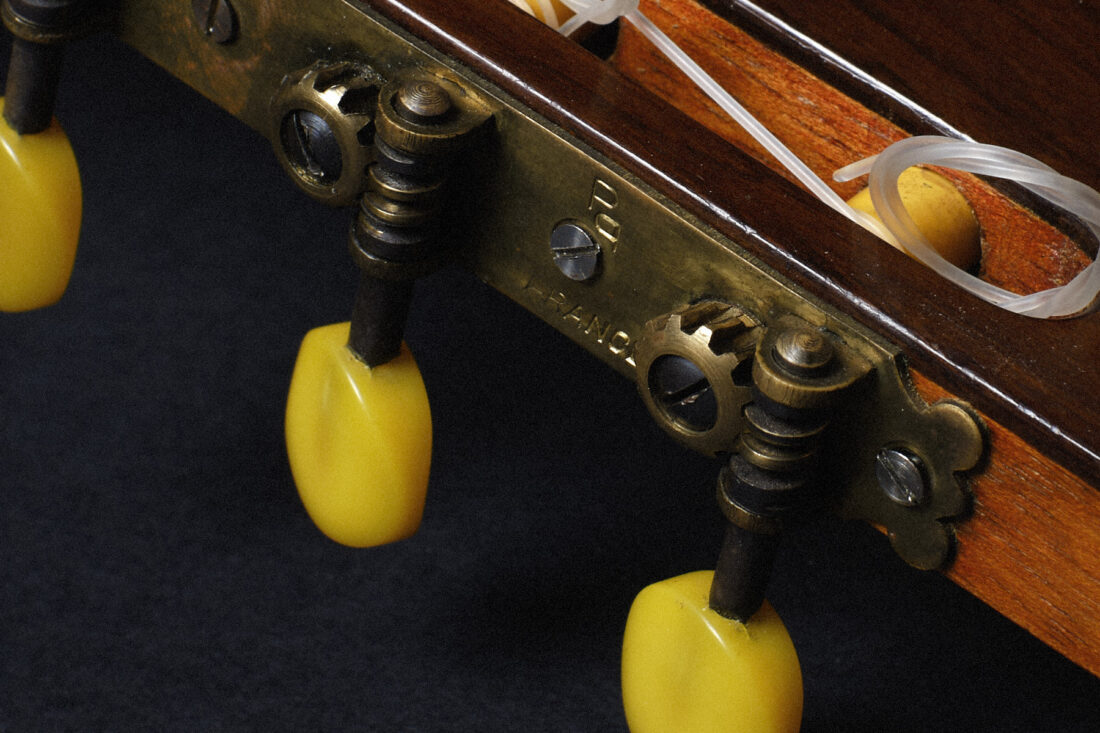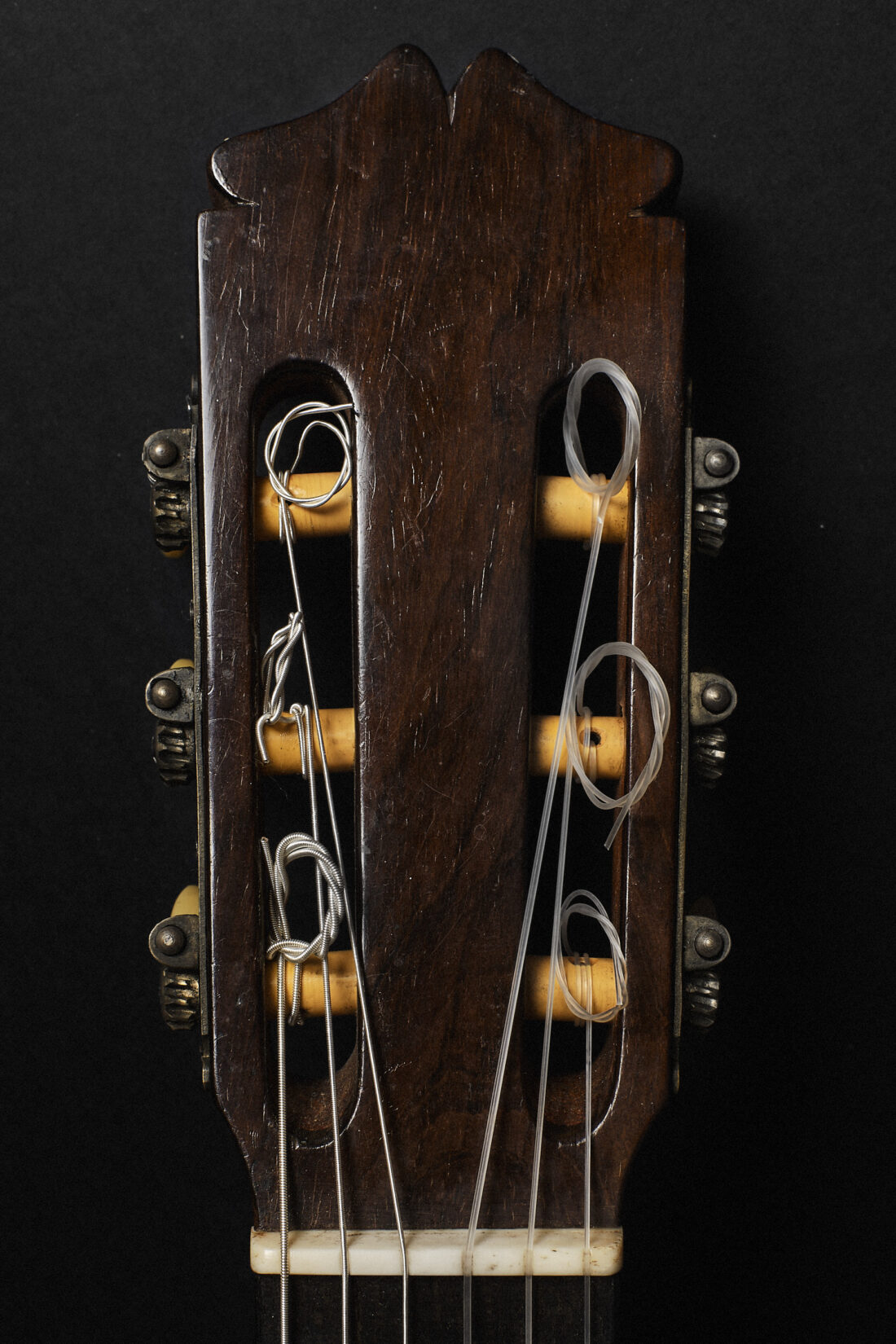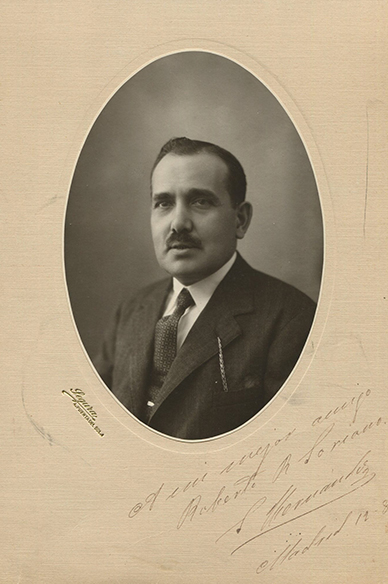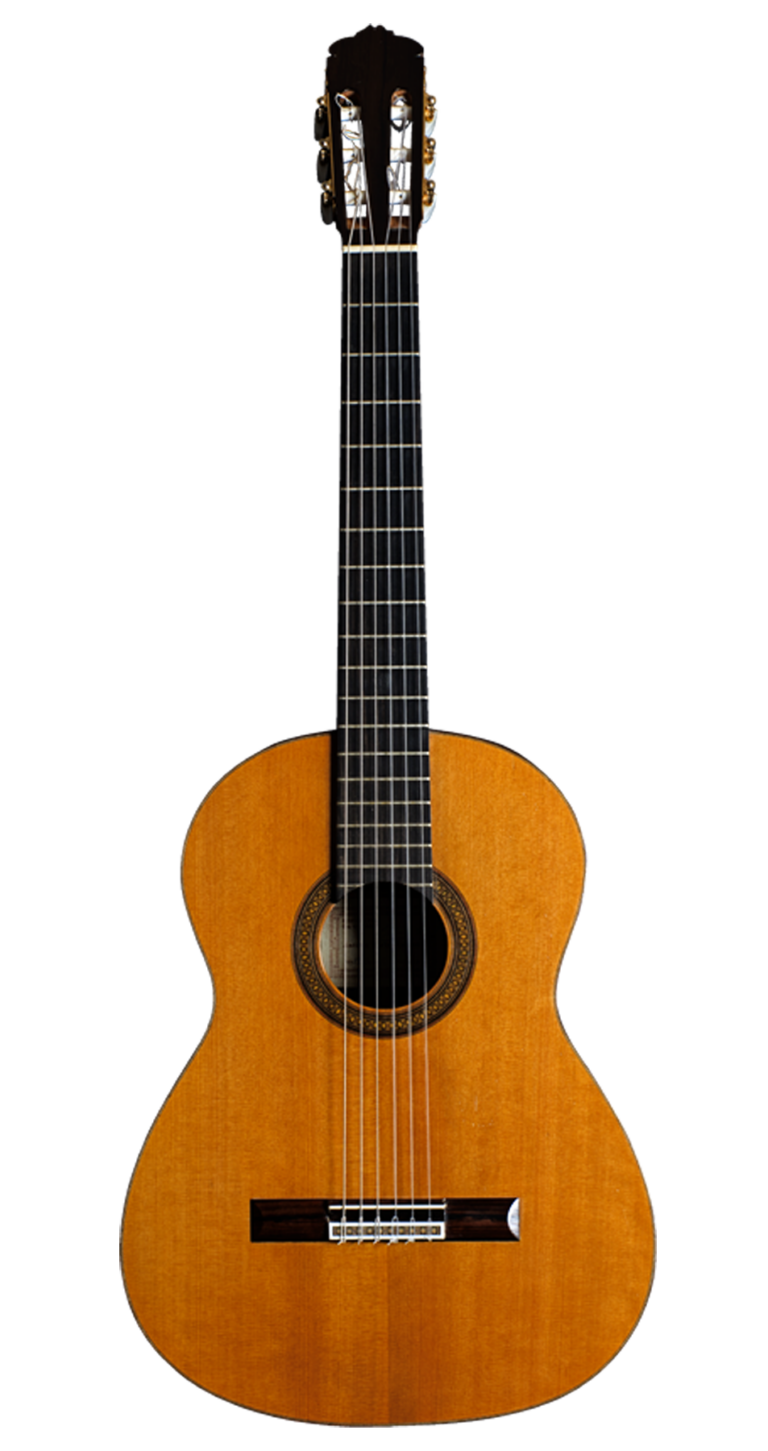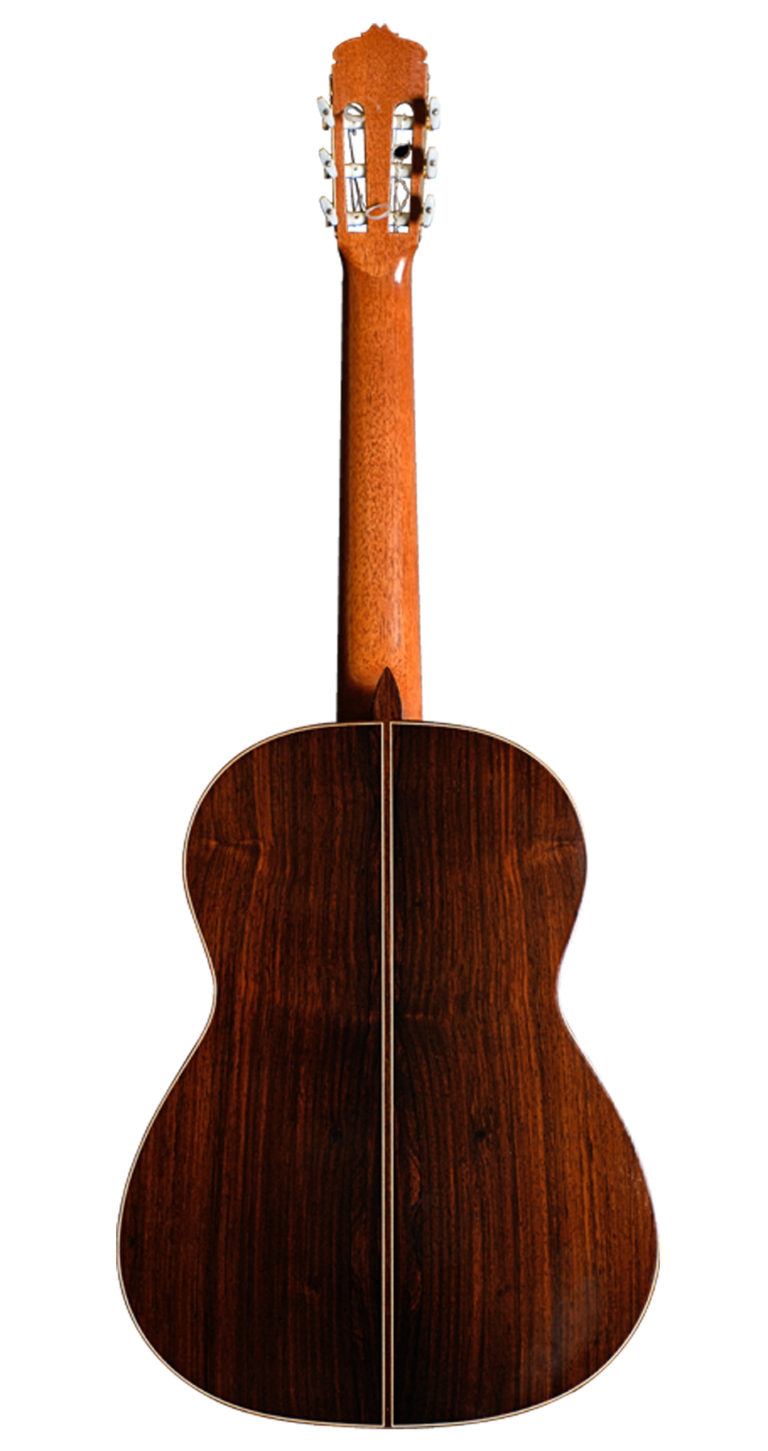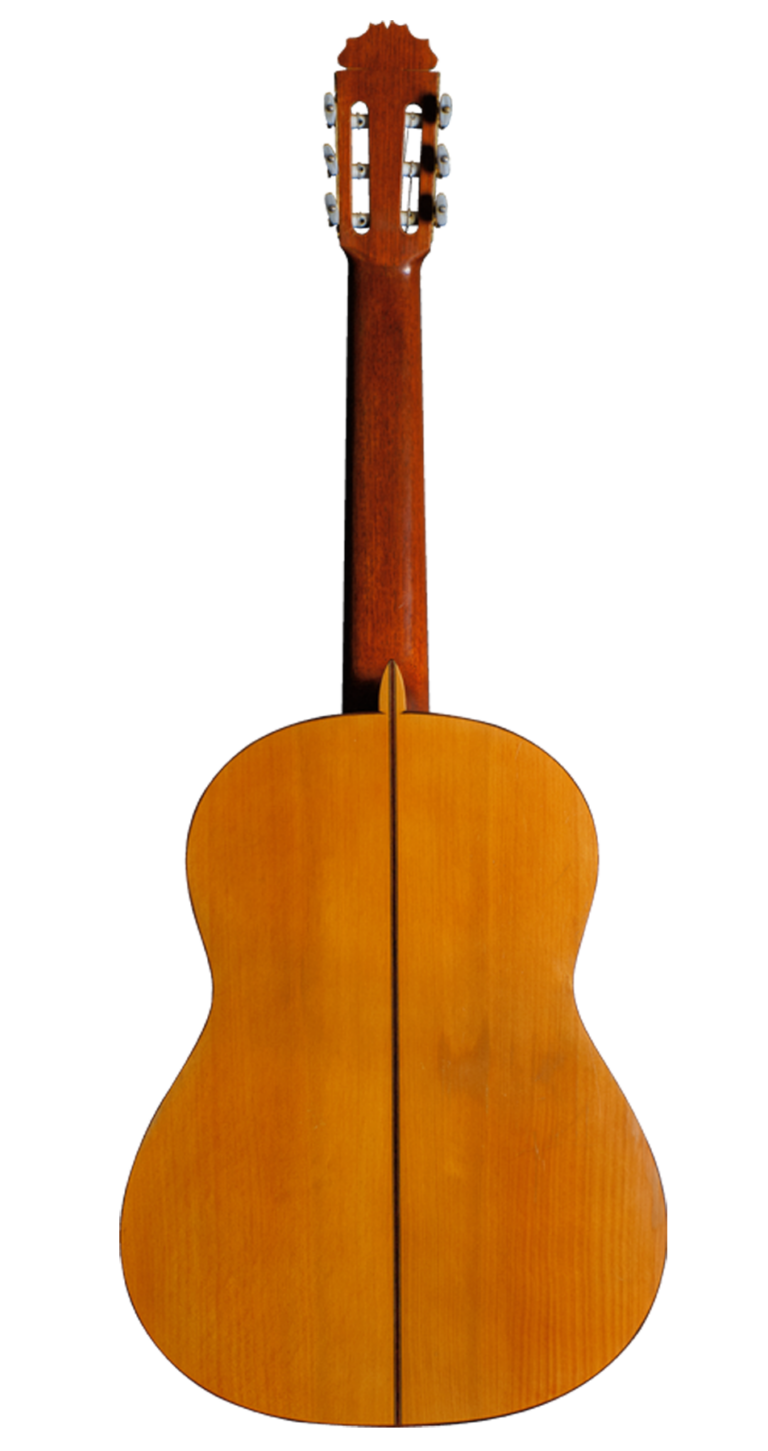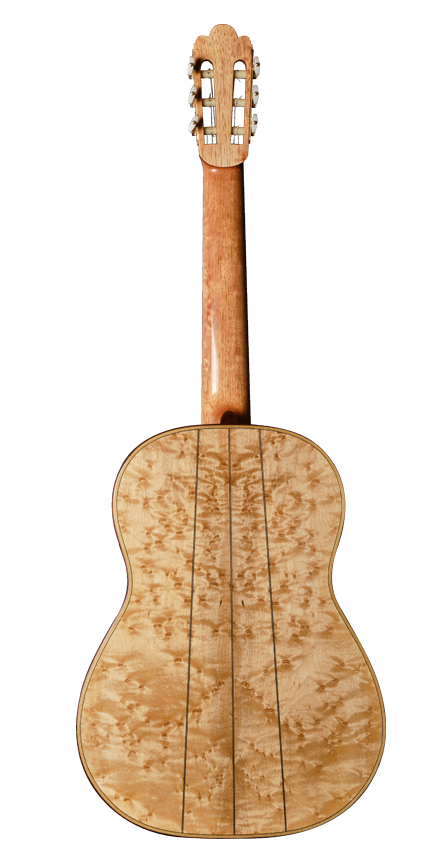Santos Hernández 1939
Construction: Flamenco Guitar
Top Wood: Spruce
Back and Sides Wood: Cypress
DESCRIPTION
Biography

DESCRIPTION
Biography
-This guitar appears in the excellent book recently published by Alberto Martinez “Santos Hernandez. Maestro Guitarrero” (page 80) as an example of the last fan bracing that Santos Hernandez used in his guitars and that was later taken by Marcelo Barbero with small variations in the struts placements as well as in the length, thickness and shape of them-
Santos Hernandez is considered among the 3 most important guitar makers in the history of the guitar. Antonio de Torres, Santos Hernandez and Hauser I.
For Madera it is an honor and privilege to have one of his guitars in our collection and especially this guitar of truly extraordinary quality.
This guitar was made by Santos Hernández in 1939, that is to say, 3 years before he died and therefore belongs to a time when Santos had reached the peak of his mastery, experience, and knowledge in the construction of his famous guitars.
It is also interesting to note that we are in the year when Spain was experiencing a civil war. So we imagine Santos making the guitar and walking through the door of his workshop in the street in Madrid where a civil war was going on.
It is worth noting in this guitar its fan bracing. Santos used it in the last part of his life and it was and is quite revolutionary. With only 5 short fans in the center and two long crossing bars. And a small cross pattern made of two very small bars and two dots in the center down part as can be seen in the image.
This fan bracing was used by his disciple, the also very famous guitar maker Marcelo Barbero, who took over his workshop after Santos’ death. For many years it was believed to be a fan bracing invented by Barbero, but this Santos Hernández guitar, together with other few existing Santos guitars that used this same fan bracing, proves that it was in fact created by Santos and that Barbero took the idea from his master and used it himself in his guitars. So this guitar has this historical value added to it.
The guitar has a crack in the top from the rosette to the bridge (see photo: 12 ) which was repaired by the most important classical guitar restorer of the last decades, Yuris Zeltins from San Diego, California. He has been a judge at the International Guitar Festival in Granada for several years and has restored all kinds of great guitars during his long career life, such as Antonio de Torres, Santos, García, Simplicio, Arias, Manuel Ramirez, Barbero… we can say almost all the famous guitars from history, at least one of each great guitar maker, have passed through his hands.
A 20mm wood graft was inserted on the upper left side. Followed by a very fine 75 mm crack down towards the rosette (see photo: 13 ).
It also has the typical crack next to the fingerboard (see photo: 14 ) that almost every Santos has and that jokingly it can be said by collectors that if it doesn’t have that crack then it is not a true Santos Hernandez.
None of this affects the sound or playability of the instrument and everything has been excellently repaired by professionals of the highest level and knowledge.
Another crack probably from a blow to one of the sides. Also very well repaired.
Everything else is in perfect condition with the typical scratches from playing a guitar made over 80 years ago can have.
Describing the sound of Santos Hernández guitars is always a difficult task. One needs to listen live to hear all the richness and sensations transmit. For many guitar experts and collectors, Santos is the guitar maker who achieved the most beautiful sound in a guitar ever created by a guitar maker.
It is a sound with spectacular clarity and definition. Truly unmatched. It has an immediate presentation. Vivid sound, with wonderful transparency. A very refined sound. And what it gives you in terms of Soul is extraordinary.
The guitar is special. From the first moment, you can feel playing something very unique. The balance is really astonishing.
The refinement, transparency, and clean sound give you purity in the sound as very difficult to see in any other.
The sound is rich, harmonically developed, it is full. The separation of voices is like perfect. The bass is resonant. Overall warmth.
The playability is also so nice and so pleasant to play. The right hand seems to play something padded that moves as you play, that is flexible. So it goes so comfortable when playing the strings, so smooth and easy. When you play you feel the whole top moving and vibrating. This effect that you feel with the right hand as if the guitar is flexible is very unusual to see. How Santos would construct the guitar to achieve this effect of flexibility is worthy of study.
Everything in this guitar is original from Santos Hernández. No single piece was added or replaced. The tuning machine is also the original one put in by Santos. We do not know the brand or factory that made it but we can see that it has the initials “P Q” and it is made in France as that word also can be seen on it (see photo: 15).
German spruce for the top and we love the Spanish Cypress used by Santos in this guitar. The famous guitar maker Jose Luis Romanillos commented on several occasions that his favorite wood for both classical and flamenco guitars is cypress. At Madera we also love this wood and in Santos’ guitars, it enhances even more that beauty of purity and clarity of sound that has rarely if ever been achieved by any other guitar maker in history.
Scale Length: 650 mm
Nut Width: 51mm
12th Fret Width: 60mm
Guitar Length: 985mm
Body Length: 487mm
1st Fret. 6th string to 1st string: 42mm
12th Fret. 6th string to 1st string: 47.5mm
Bridge. 6th string to 1st string: 57mm
Side Width Upper body: 90mm
Side Width Lower body: 92mm
12th fret to 6th String Height: 3.5mm
12th Fret to 1st String Height: 2.6mm
Weight: 1230g
Original Tuning Machine made in France with initials P/Q
Bracing pattern

Santos Hernández Rodriguez was born in Madrid in 1875 and also died in Madrid on 8 March 1943.
Together with the guitar maker Antonio de Torres, he is considered the most famous Spanish guitar maker in history.
For many, he is also the guitarrero who has created the most beautiful sound in the whole history of the instrument.
He started the guitar making career at a very young age in the workshop of the guitar maker Valentín Viudes, from Valentín’s workshop he went on to work briefly in the workshop of the guitar maker from Granada, José Ortega, who was based in Madrid. From this workshop, he moved on to the one located in Calle Carretas 33, which belonged to the heirs of Francisco González (Hijos de González).
The last workshop that Santos Hernández worked for others was that of the historic guitar maker Manuel Ramirez. He stayed there until the death of his master Manuel in 1916. In the same year, Santos founded his own workshop at number 27, Calle Aduana. A street located in a very central part of the Spanish capital and very close to the most famous square in Madrid and also the most famous in Spain called Plaza del Sol.
We can see that the trajectory of Santos Hernández is quite impressive as he has been working in so many famous and historical workshops, especially that of Manuel Ramirez. And therefore the great knowledge and experience he already had before opening his own workshop.
Santos Hernández was already very famous during his lifetime, and he received orders by mail from all over the world, the vast majority of which Santos was unable to carry out. It is said that he had a very good collection of stamps from all over the world from the countless letters he received every year asking him to make a guitar. All the great Santos contemporary guitarists, both classical and flamenco, wanted to have a guitar made by him and it was considered a great privilege to have one of his guitars.
The famous classical guitarist Regino Sainz de la Maza was a good friend of Santos Hernandez. Regino played with a Santos Hernández guitar made by the maestro in 1934. This guitar made back & sides with maple wood had also the name “La Rubia” (The Blonde). La Rubia was a historic guitar as Regino played with it the Concierto de Aranjuez for guitar and orchestra composed by the composer Joaquín Rodrigo at the Palau de la Música in Barcelona on the 9th of November 1940. This concert was the world premiere of this concerto, the most famous and most played concerto in the history of the classical guitar.
Regino liked to visit Santos in his workshop in Calle Aduana on a regular basis. In a very interesting press article written by Regino in a Madrid newspaper with the title: “El Artesano Santos Hernández, armador de guitarras”, Regino comments that when he opened one of the letters from someone who wrote to him asking for a guitar, Santos replied: “But it takes me 4 months to make one!”. Regino tells us in this article that Santos liked to work alone and every detail of the instrument was made and controlled by him. In another article about an interview with Santos Hernandez written by Spanish journalist Paulino Masip in 1929 ( Revista Estampa ) Santos says “ it takes me a month or more than a month to make a guitar. But I don’t know because I never make only one at a time “. As is often the case, guitar makers normally make two, three, four, or even more at the same time spending months to finish them all together.
Santos liked to control the entire construction process himself without any help.
Regino Saiz de la Maza comments: “Santos takes a long time to make a guitar… he turns a piece over a thousand times before putting it in place… nothing matters to him except that his instrument is perfect”. He also tells us that the workshop is simple. With subtle and primitive tools. And a very small lathe. And that the workshop smelled of “delicate resins and varnishes”.
There is also a very old carpenter’s bench and the mother-of-pearl and ivory pieces shine.
In the midst of all this, there is always “the silent and tacit figure of Santos Hernández… A quiet man with a broad, good-natured and somewhat sly smile”.
Santos’ workshop was frequented by many guitarists, many of them famous, who spent hours with the master, talking to each other and playing while Santos worked. A truly special atmosphere. A kind of cultural center was formed there around the guitar and everyone appreciated the noble and generous character of the great master Santos Hernández.
One of Santos’ most famous guitars was the one used by Andres Segovia in his concerts from 1912 to 1937. With a beautiful story behind it.
Andrés Segovia himself tells us that when he was very young he went into the famous workshop of Manuel Ramirez at number 10 Calle Arlabán to rent a guitar.
There he met Manuel Ramirez himself who, on seeing him badly dressed, told him that he would not rent him a guitar. Segovia took a guitar that was in the workshop and began to play while Manuel Ramirez looked at him sideways. He told him again that he was not going to rent him any guitar, went to the back room and took out a guitar, and told him again: “I am not going to rent you a guitar. Take this one and walk around the world with it” He didn’t rent it to him, he gave it to him as a present.
That guitar was one made by Santos Hernández who at that time, as we have said, worked in Manuel Ramírez’s workshop.

DO YOU WANT TO BE INFORMED WHEN ANOTHER GUITAR FROM THIS GUITAR MAKER WILL BE AVAILABLE? LEAVE US YOUR EMAIL AND WE WILL KEEP YOU INFORMED.
FOR ANY QUESTIONS OR INFORMATION ABOUT UPCOMING AVAILABILITY OF A GUITAR FROM THIS GUITAR MAKER, PLEASE CONTACT US AT MADERA@MADERAGUITARS.COM
